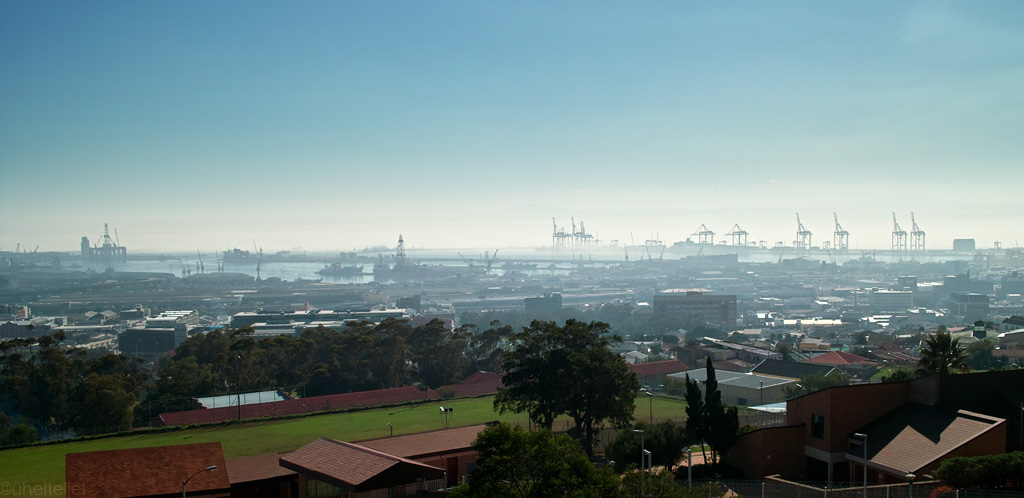No one really knows how Coffee Bay, a village on South-African east coast, got its name. Some guess that it might have been due to a ship carrying a load of coffee crashing on the shore. But it does not really matter as the place draws people like the smell of fresh coffee in the morning. Normally we are skeptical towards places that are too popular, but soon enough we had to put our preconceptions behind. Quite unlike its cosy, trendy name, it has real power. We spent hours on the beach observing the battle between water and wind, climbing the overgrown hills above the ocean, until the sun had set.
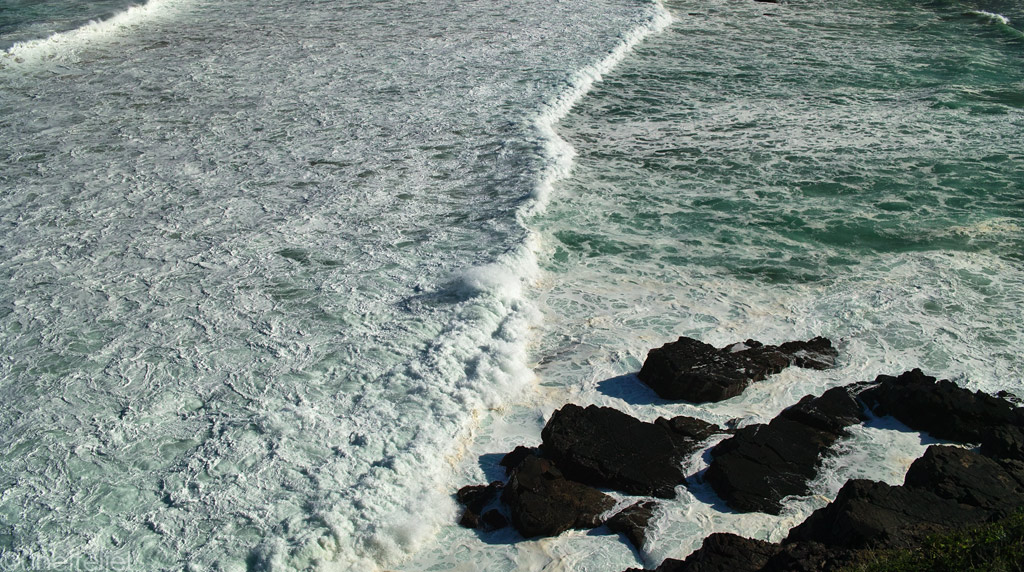
Waves in Coffee Bay.
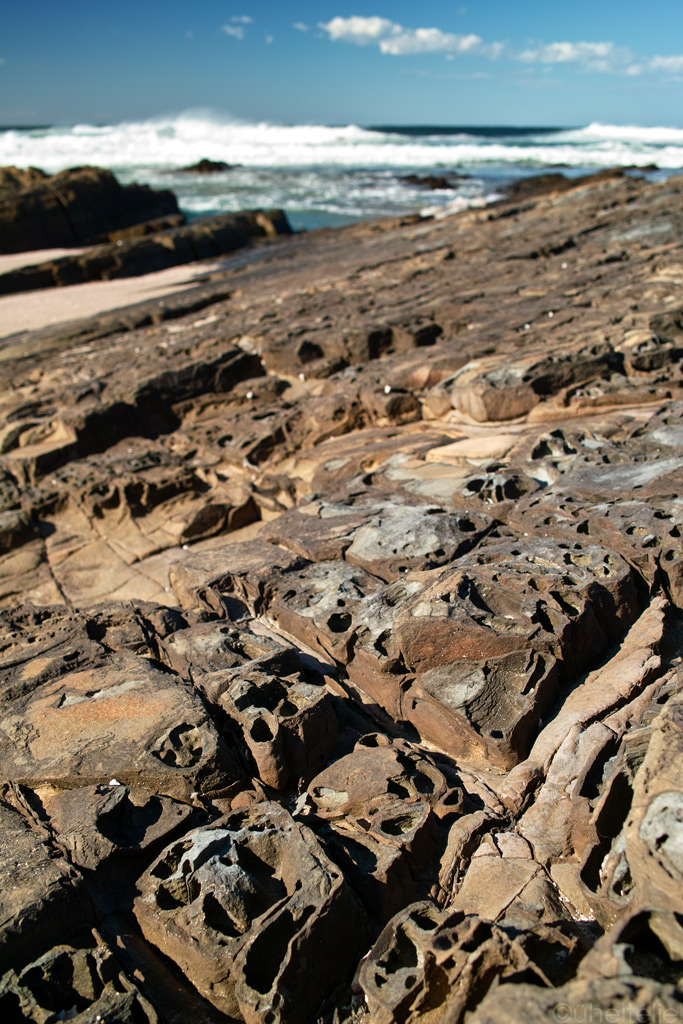
Interesting rock formations on the beach.
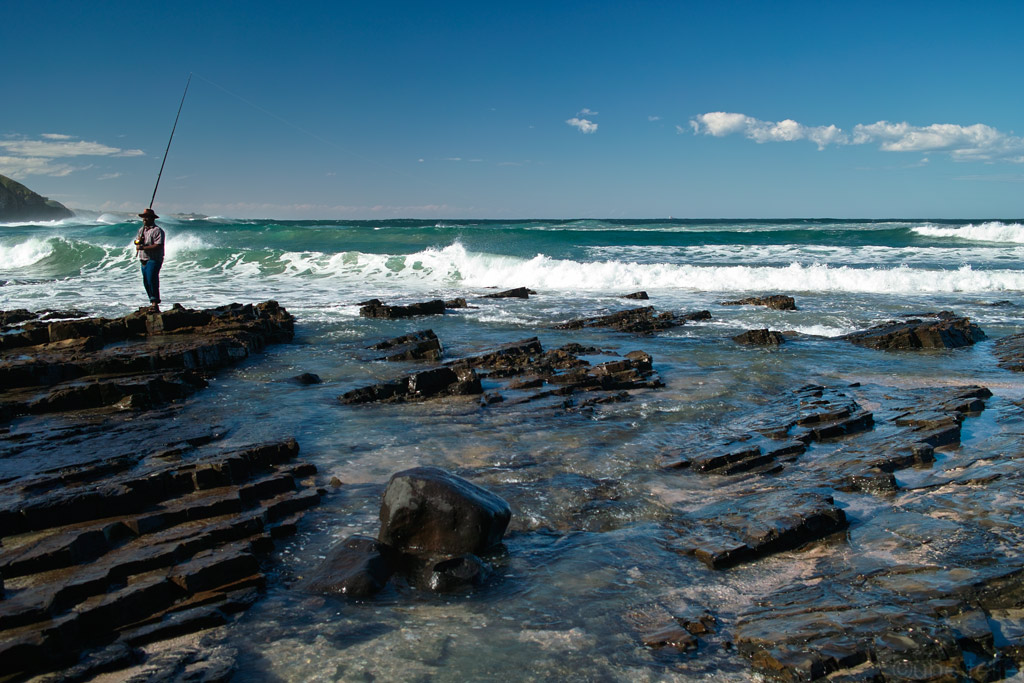
Fisherman at Coffee Bay.
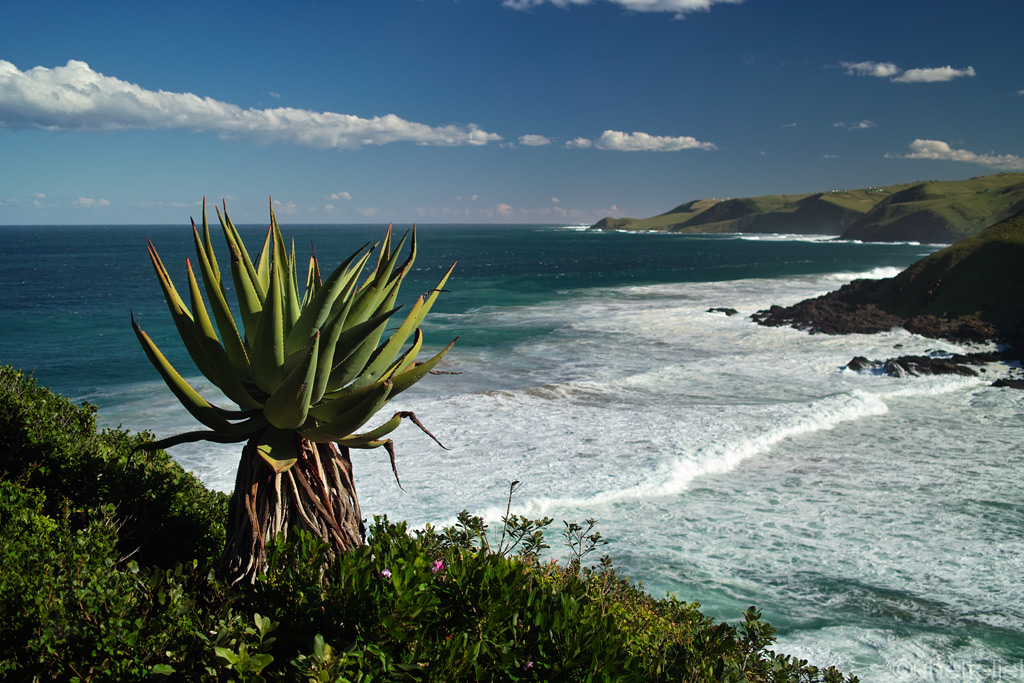
Funky plants at Coffee Bay.
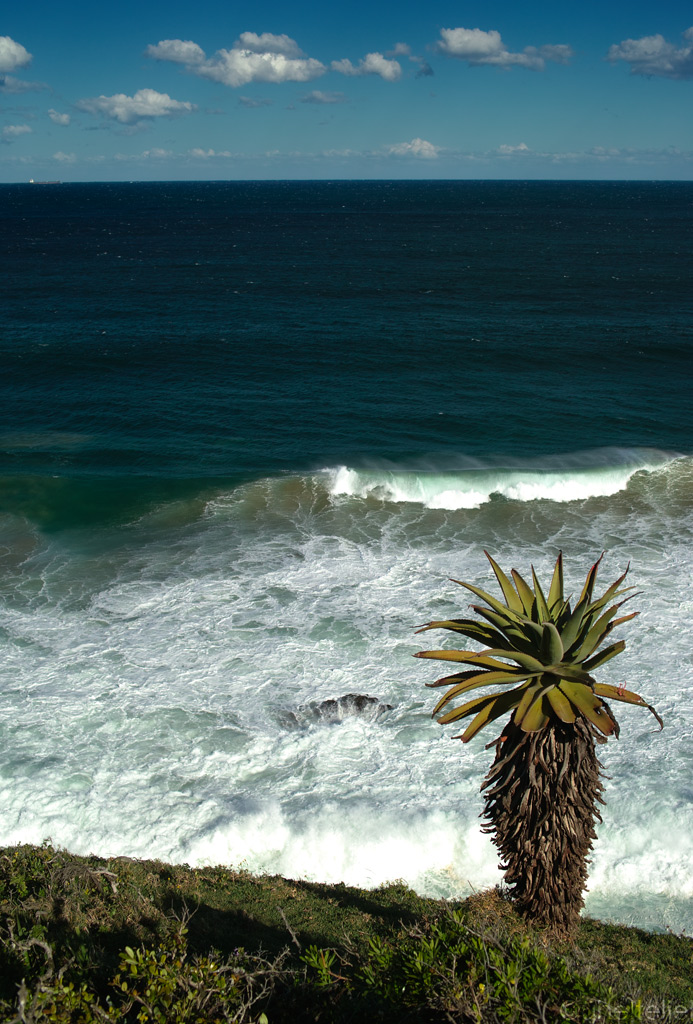
A breaking wave and a funky plant.
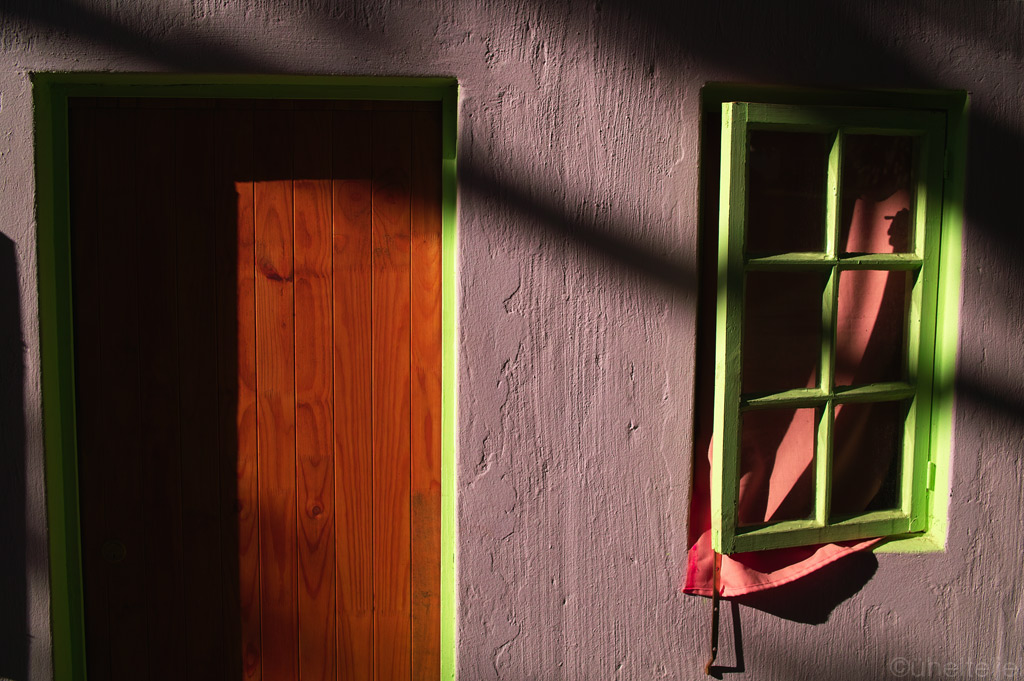
Someone's door and a window, early morning at Coffee Bay.
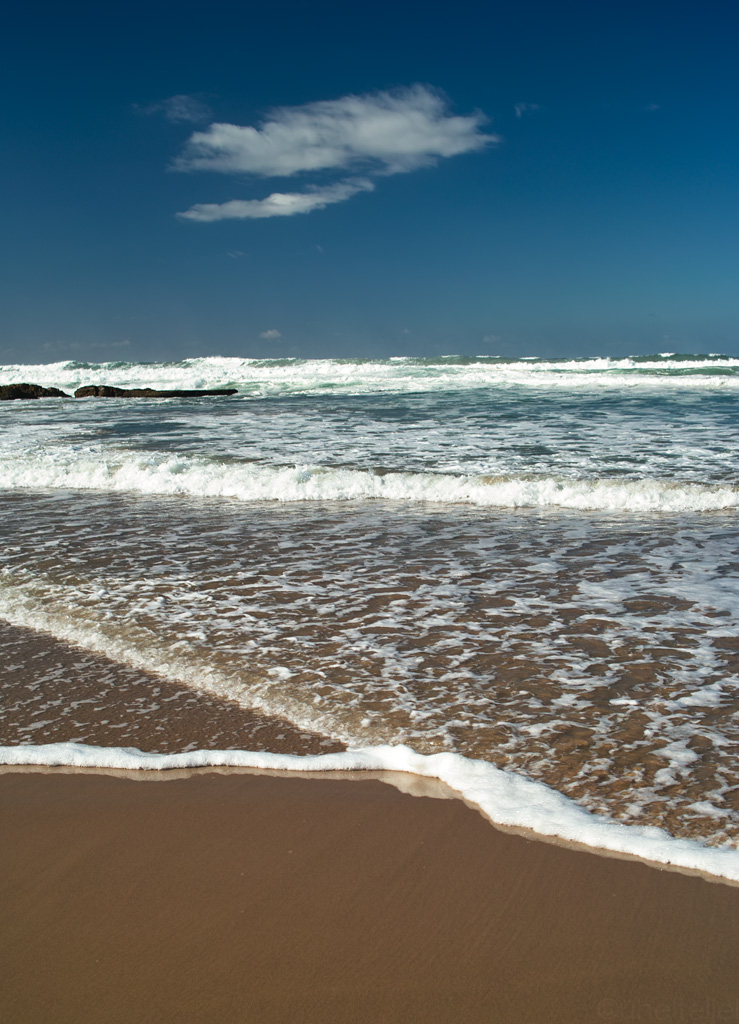
Waves coming in at Port St. Johns, short distance away from Coffee Bay.

Panorama from Port St. Johns beach (click to enlarge)

Panorama of Coffee Bay (click to enlarge each panorama)


Panorama from another bay in Coffee Bay.

Panorama from Coffee Bay's rocky side of beach during dusk.


Panorama from a hiking trail somewhere in Coffee Bay.
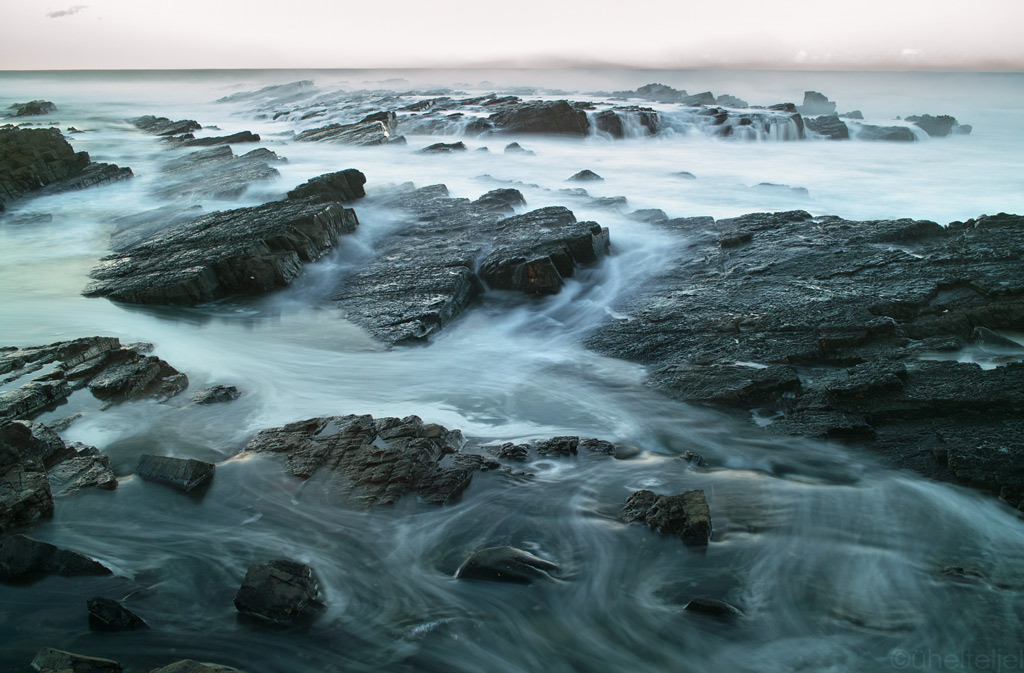
Water against the rock...
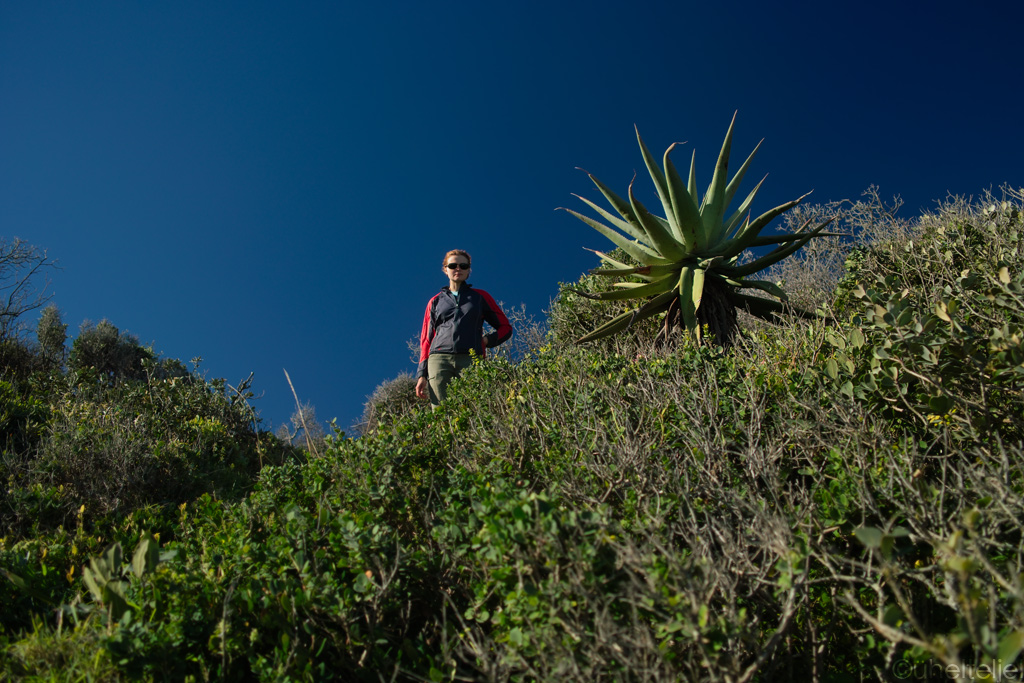
Somewhere on the hiking trail.
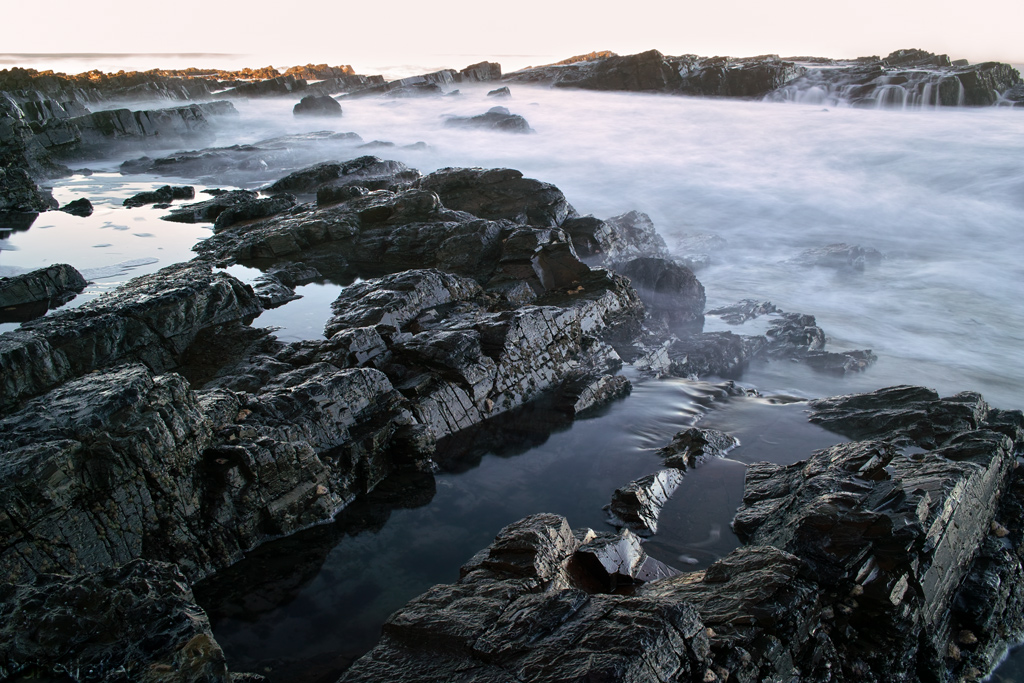
Water coming in.
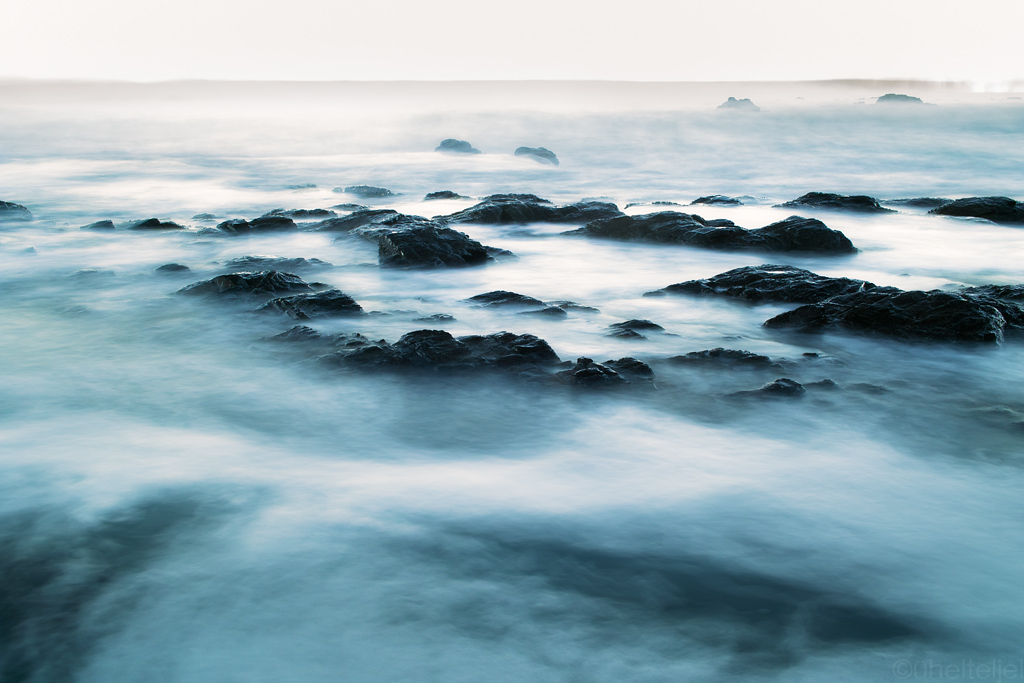
Play of the waves, stillness of the rocks...
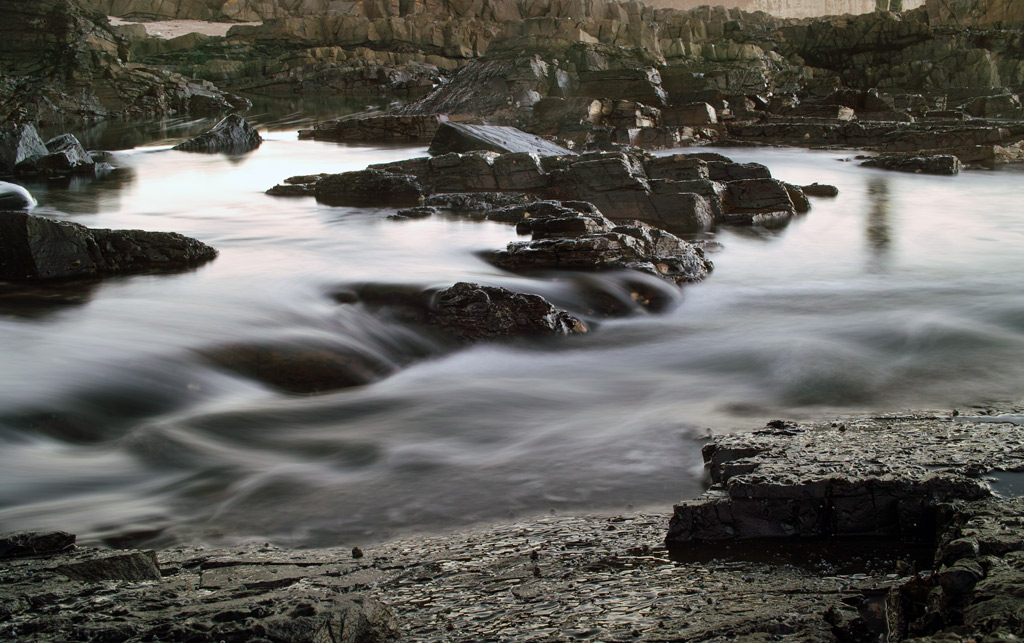
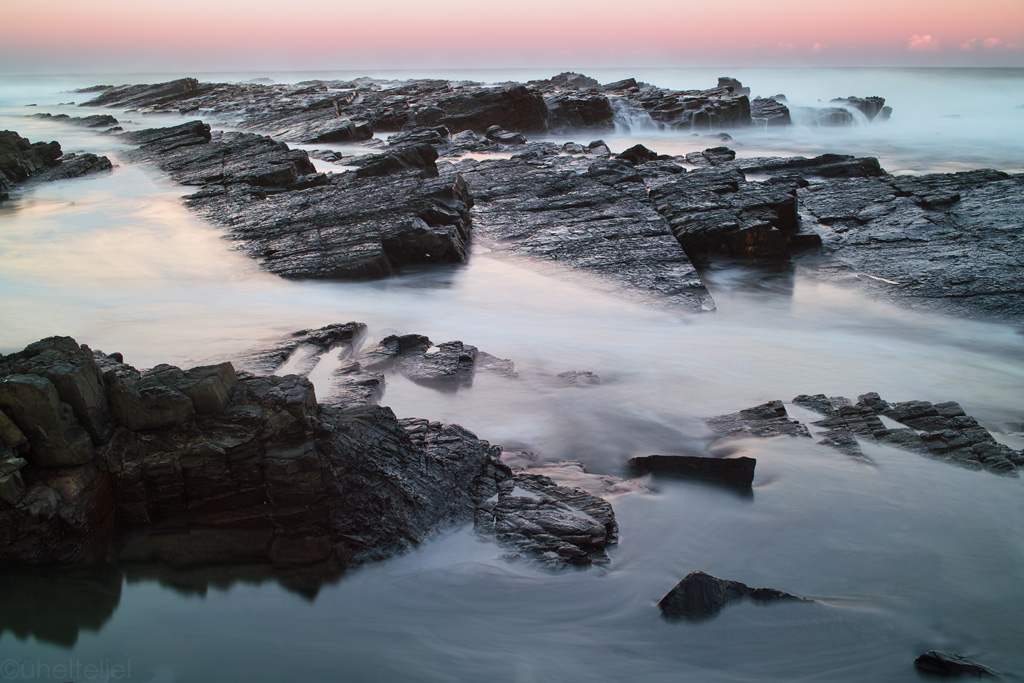
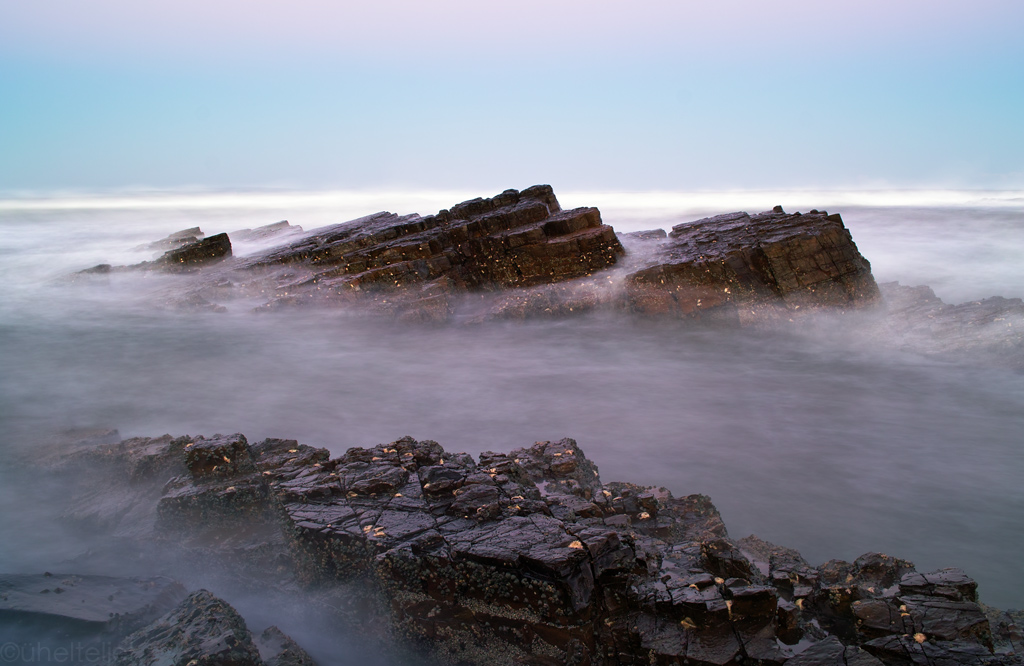
After having seen enough of the frothy waters we headed to Gonubie, a town near East London. We were greeted by Michnus and Elsebie whom we had already met in Nairobi - they're both traveling on a F650 GS, and they had just left their bikes in Addis Abeba and flown back home to work for a while before continuing their journey somewhere north. They suggested we'd stay for a couple of days and that's what we did - exchanging our stories, drinking damn good Ethiopian coffee, having jaccuzzi, eating all sorts of delicacies such as BBQ'ed ostrich and the local speciality, biltong, and even meeting the epic ADV famer Metaljockey who lives only two houses from Michnus and Elsebie. We were totally spoiled!
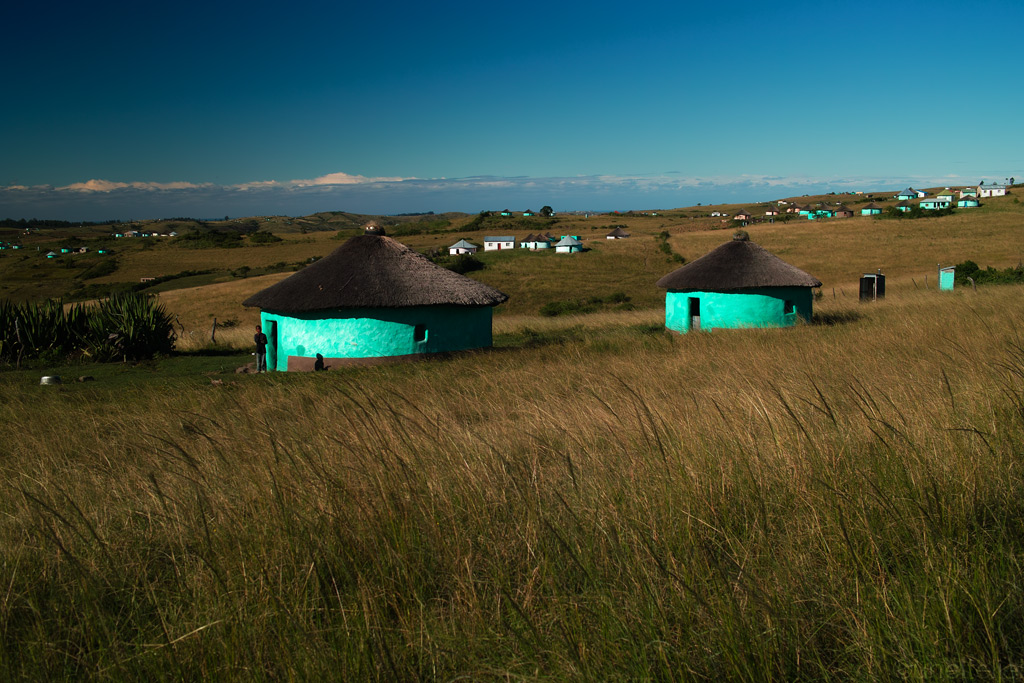
Typical anvironment and architecture in the windy Transkei region - this is the Nelson Mandela land!
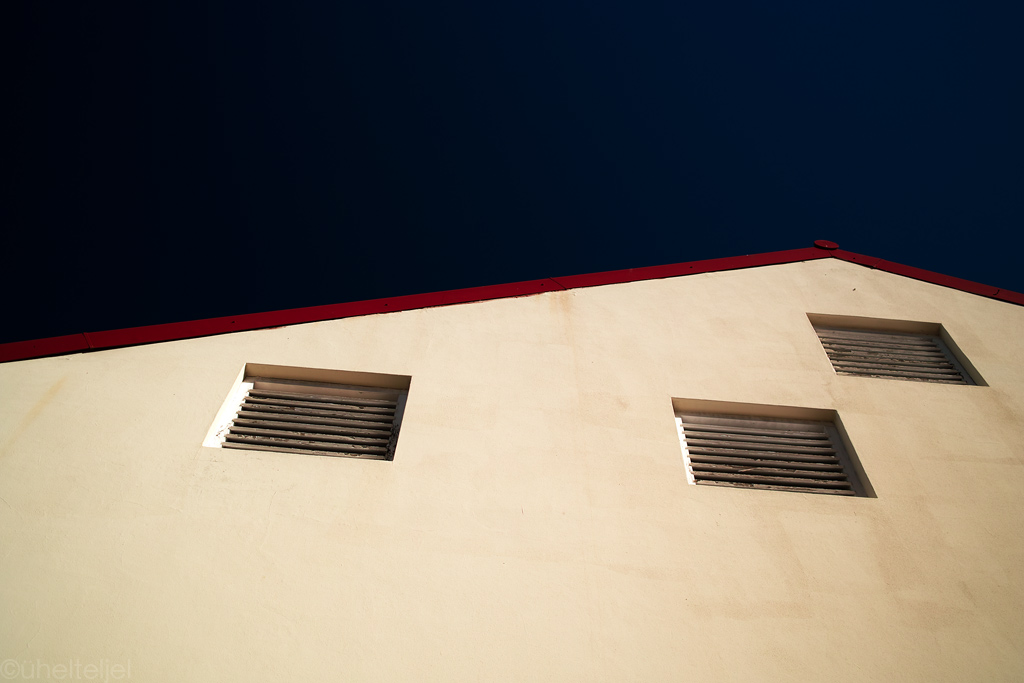
A house in East London.
The southern coast of South Africa has a different kind of aura. Kind of more peaceful and relaxed. And even though the ambience in the towns lining he Garden Route becomes more exclusive, and maybe even more cocky as we near Cape Town, the nature itself expresses itself in a rather sedate way.
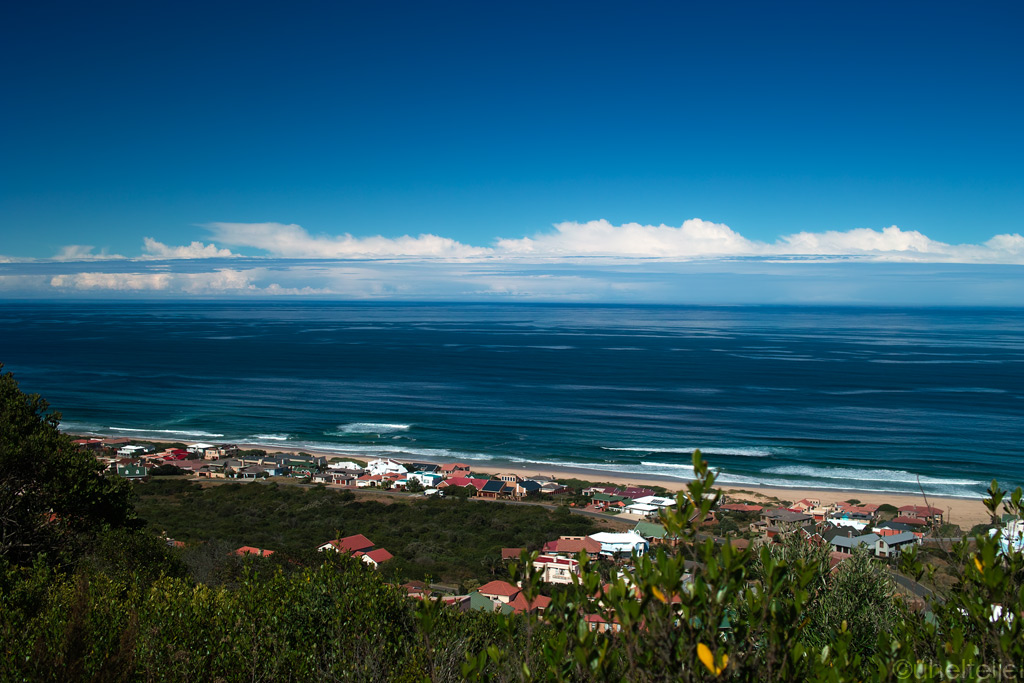
Indian Ocean coast in South Africa.
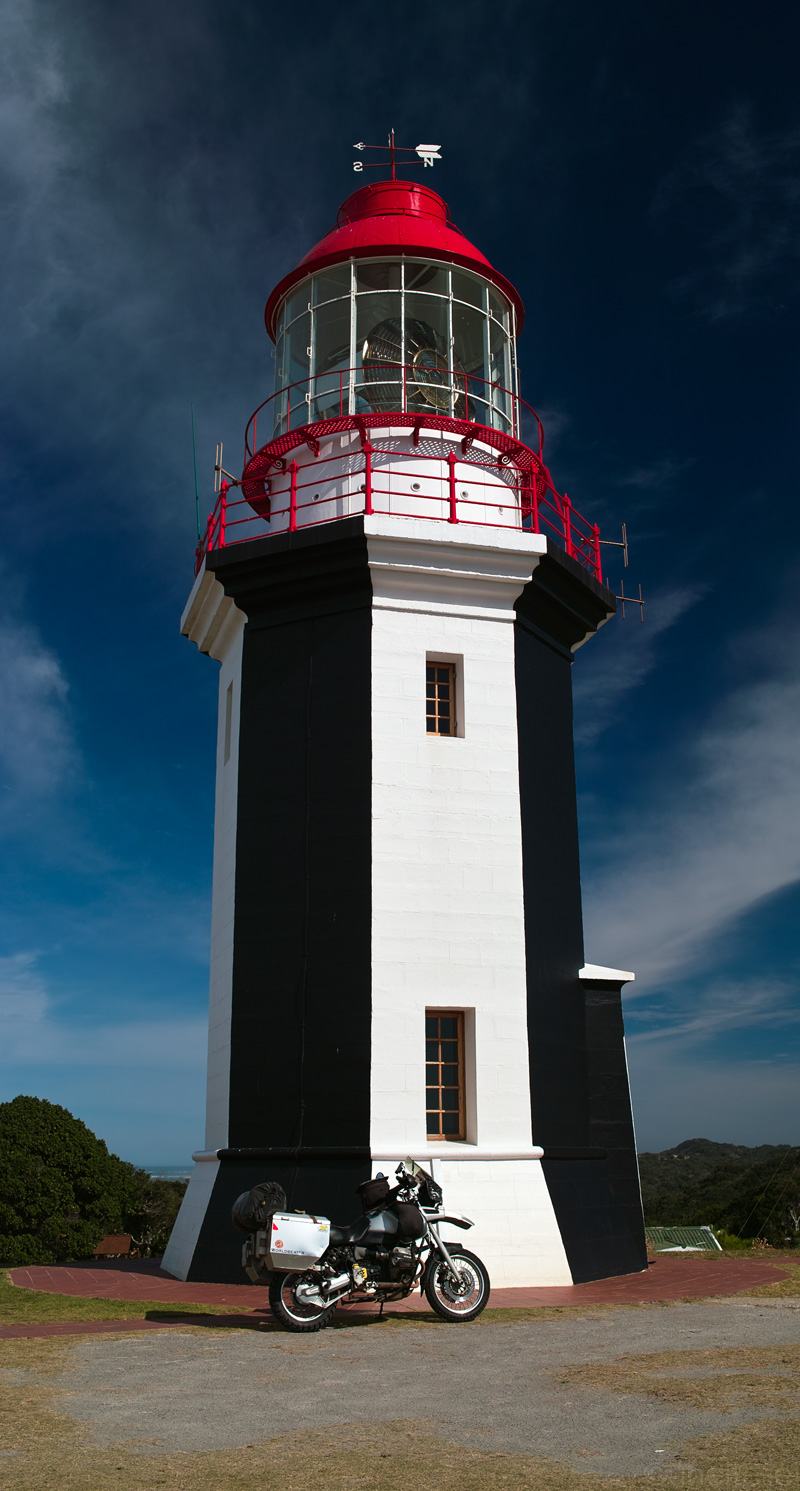
Under a lighthouse built around the 19th century.
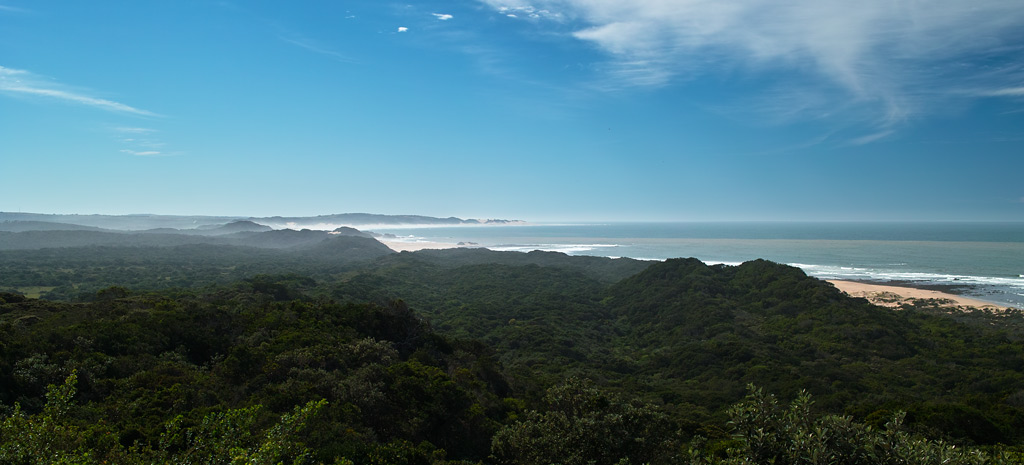
Indian ocean coast seen from that lighthouse.
The frigid waters bashing against the rocks, green fairytale-like hills rising in the background, the sky stretching towards the distant horizon - it must take a hell lot of will to keep all this might at bay. But there you stand on the shore, the waves splashing in front of your feet and the wind tearing your hair, and yet you do not feel overwhelmed. It is not trying to impress you to satisfy its vanity, instead it lets you decide what to think of it…
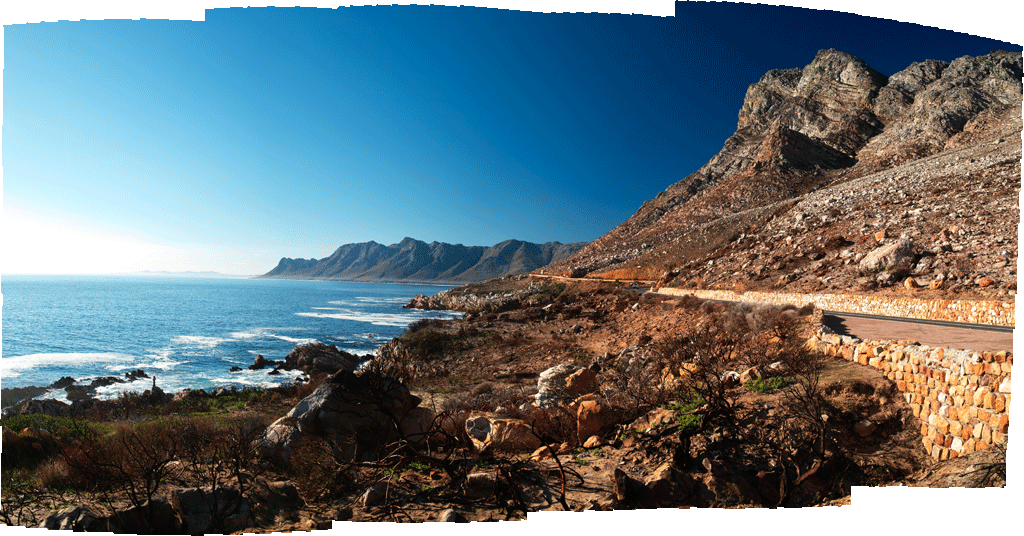
Panorama from the coastal road in South Africa (click to enlarge)

Panorama from False Bay.
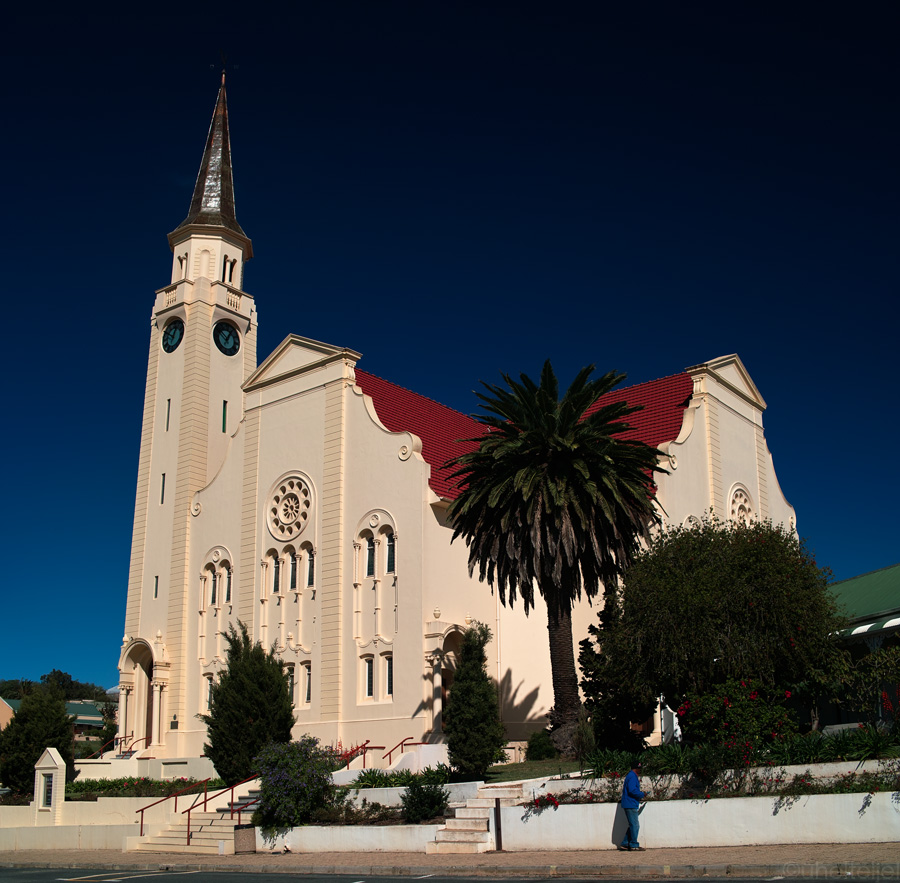
A huge church in a small town in South Africa.
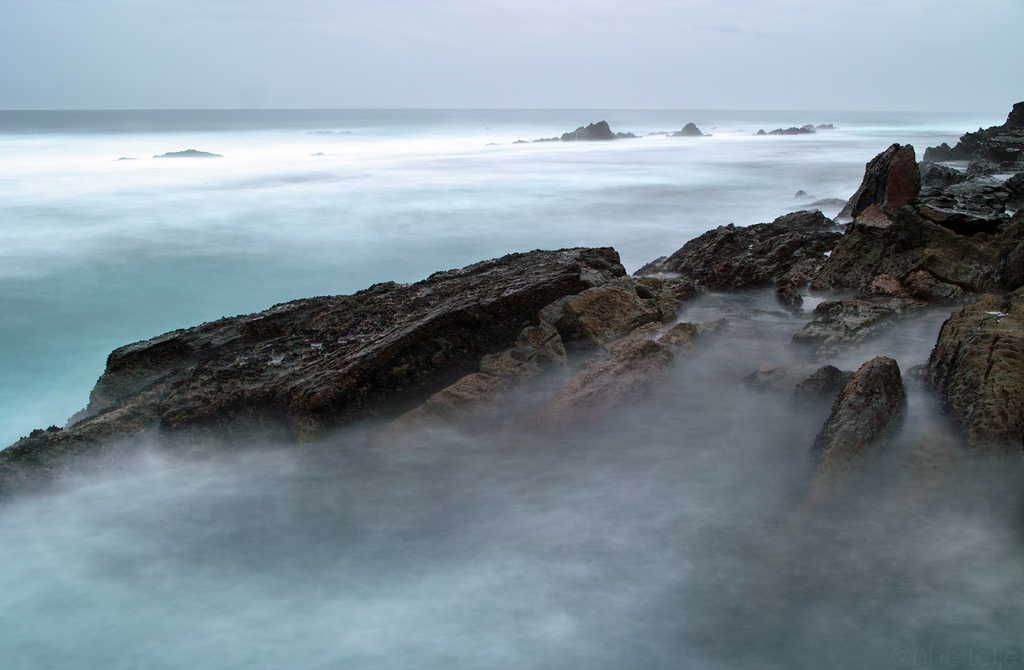
Waves in Tsitsikamma national park.
Sound from the same spot:
...::: LISTEN :::...
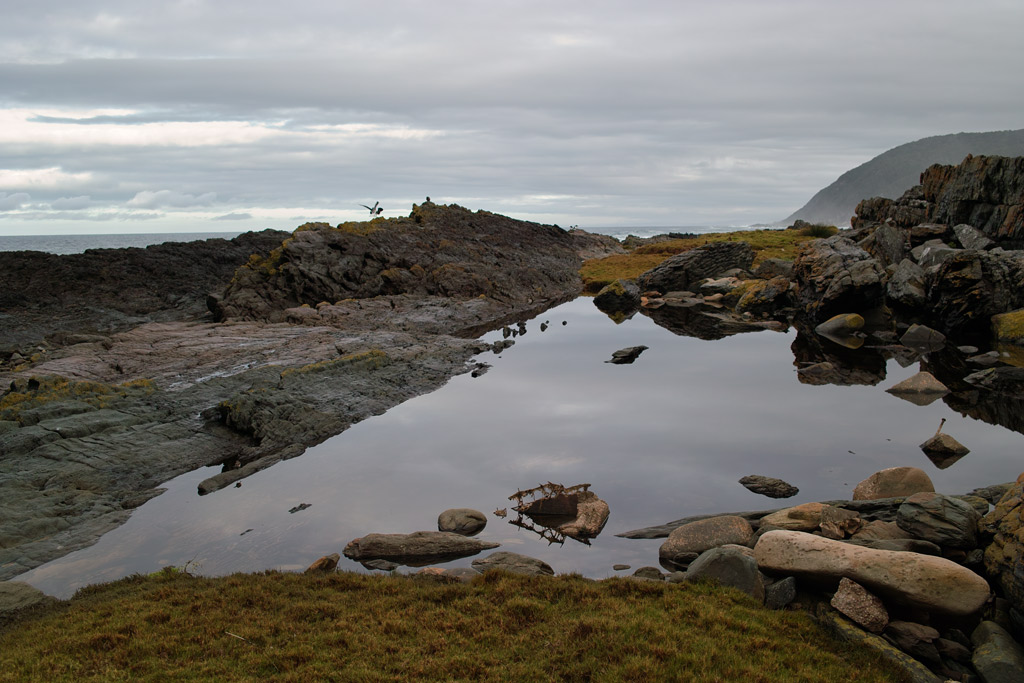
Still waters and seagulls in Tsitsikamma.
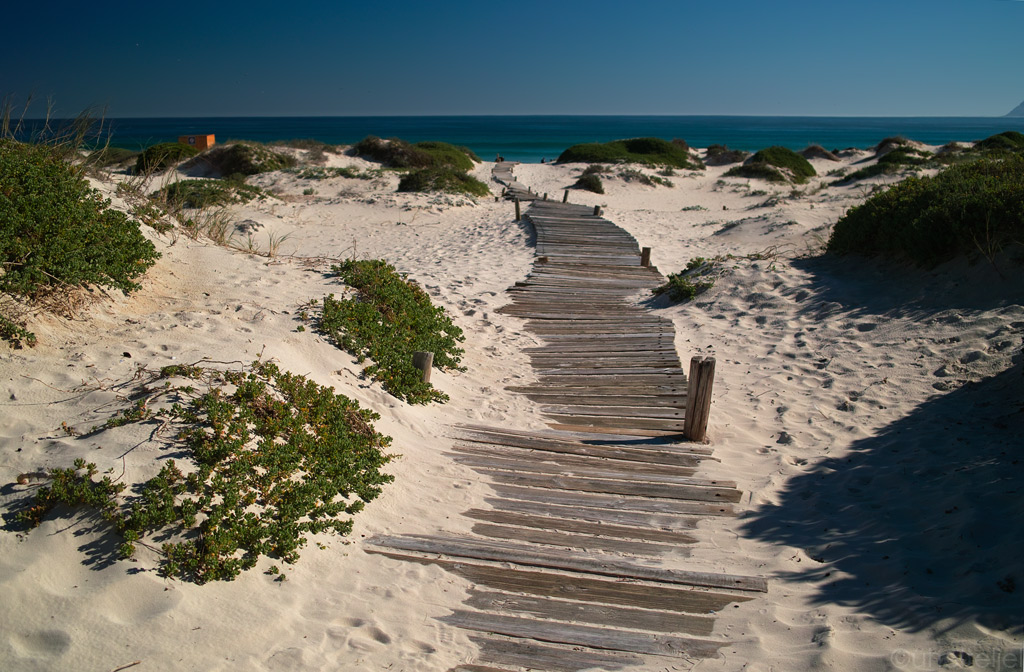
Trail to the beach.
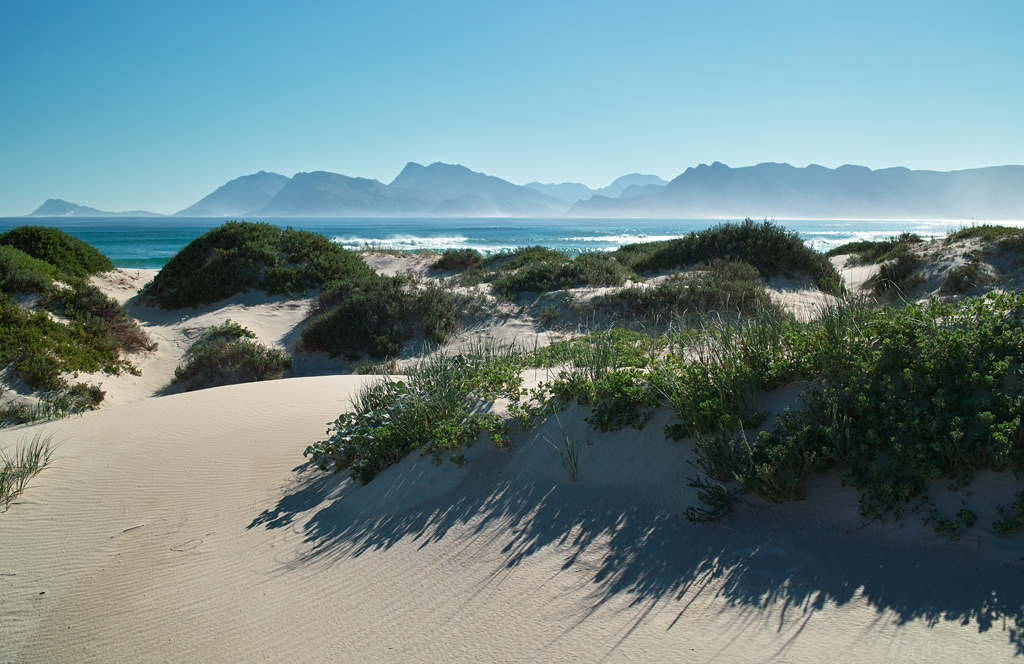
Sandy landscapes near the Indian ocean.

Panorama from that world famous peninsula - somewhere there is Cape of Good Hope (click to enlarge).
Sure enough we could not miss Cape Agulhas, the southernmost point of the African continent. As exciting as such landmarks are, this one is sadly destined to be the one that marks the true start of our journey home as we will only be moving north from here.
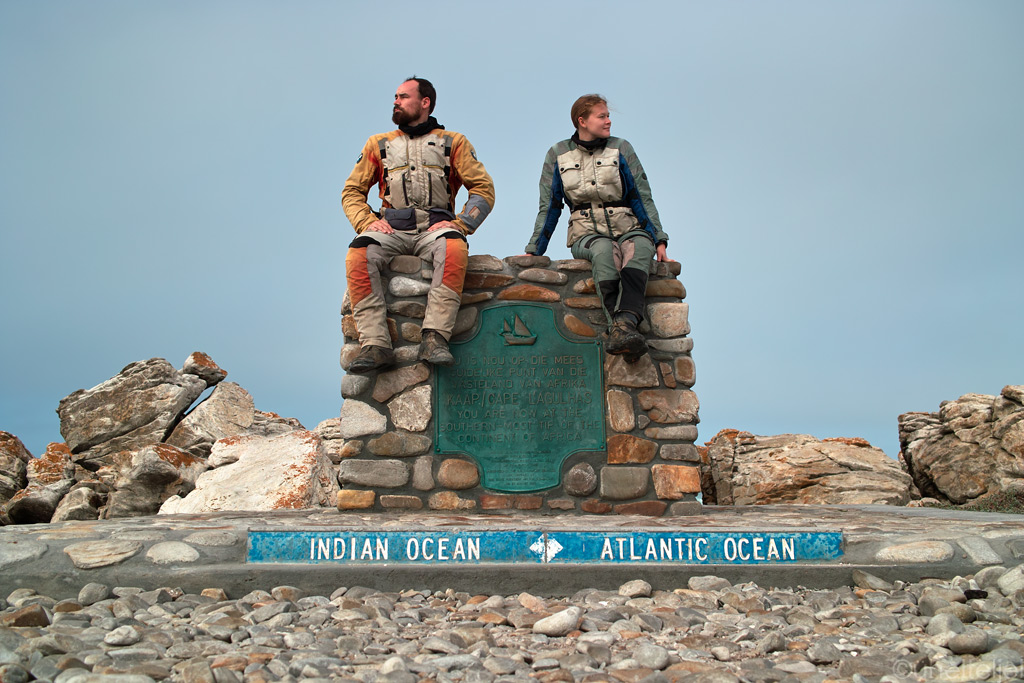
Us in Cape Agulhas - one wants back to the less visited Indian Ocean countries, other to the more "homey" Atlantic Ocean countries.
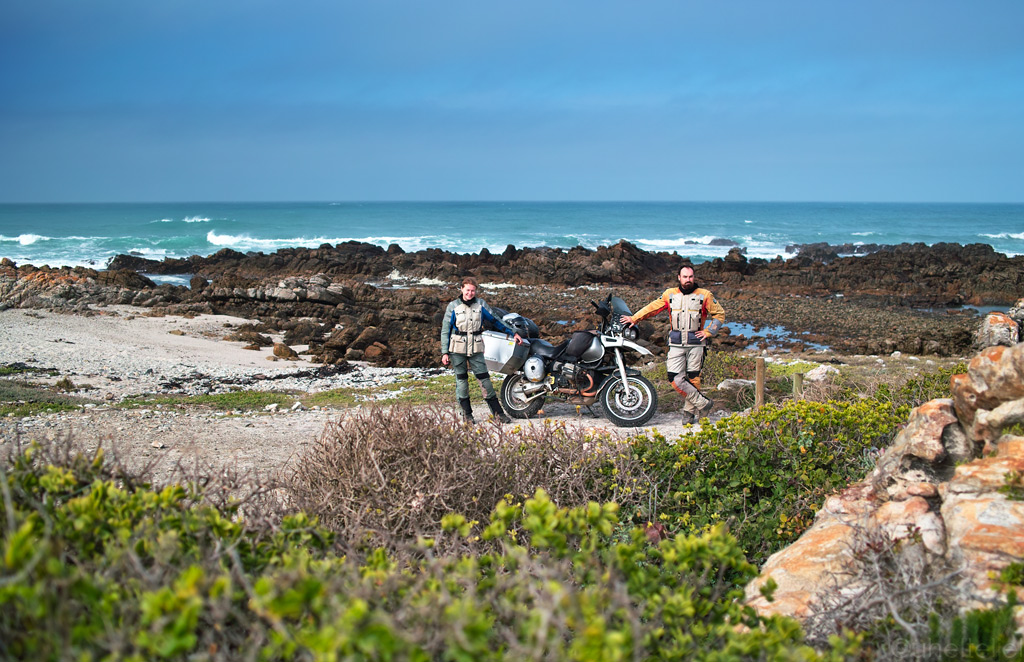
This is how the most southern point of African continent looks like.

Panorama from Cape Agulhas (click to enlarge)
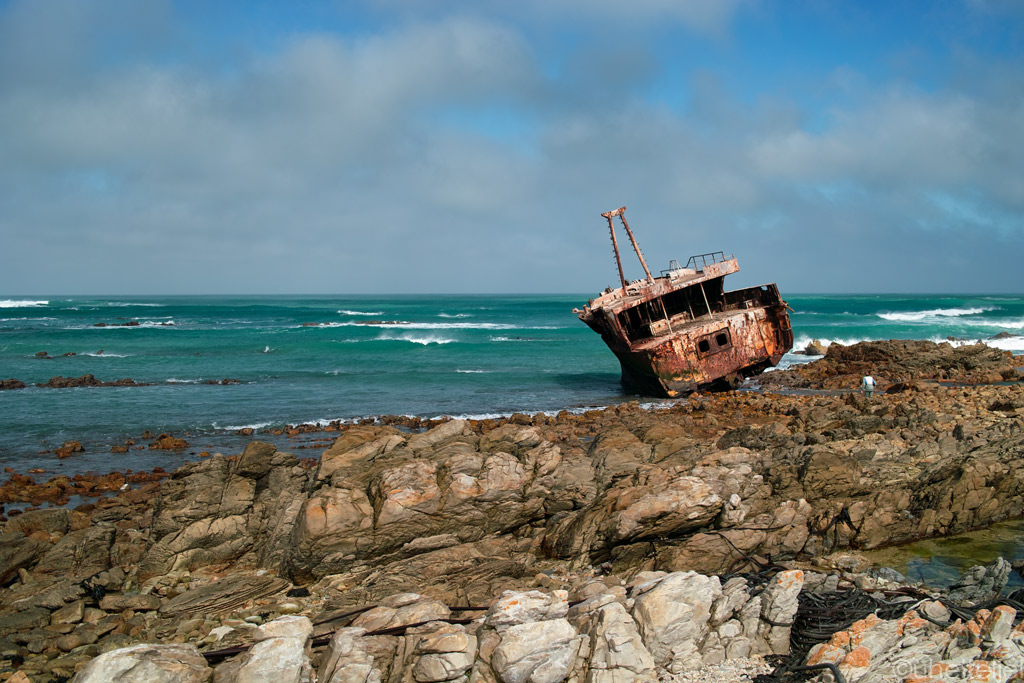
A sunken Japanese ship in Cape Agulhas.
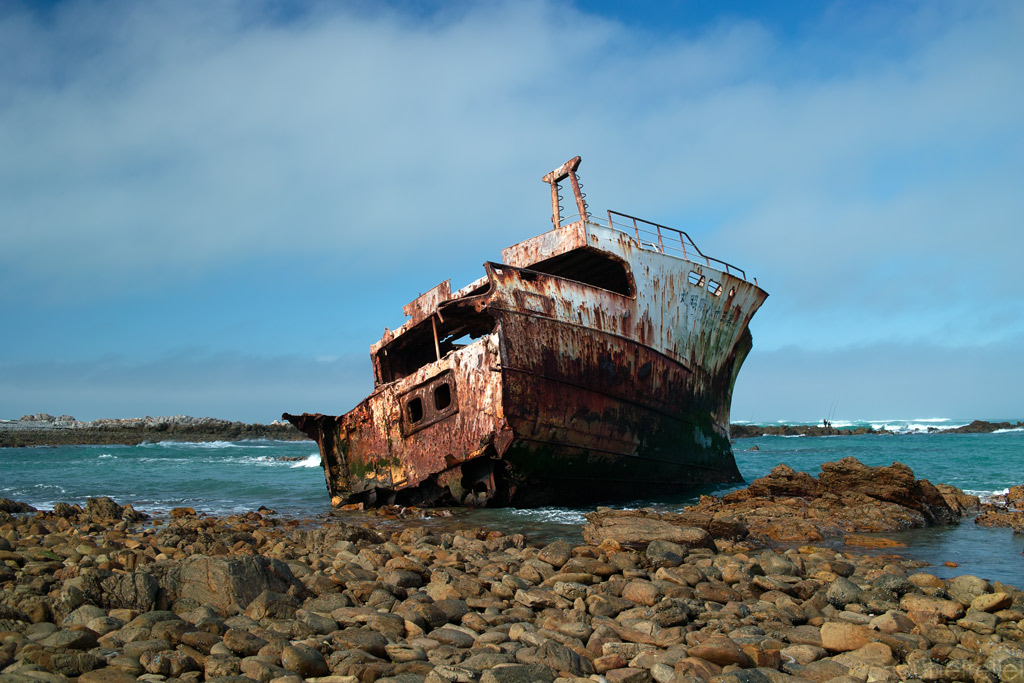
The same Japanese ship, see the fisherment in the background?
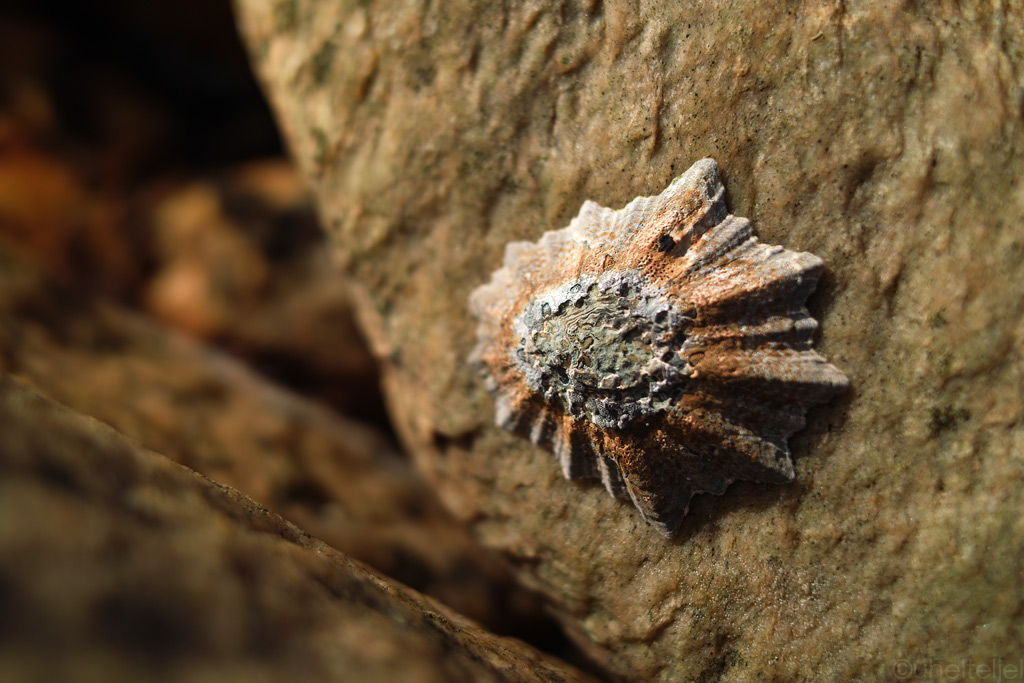
Life on the rocks.
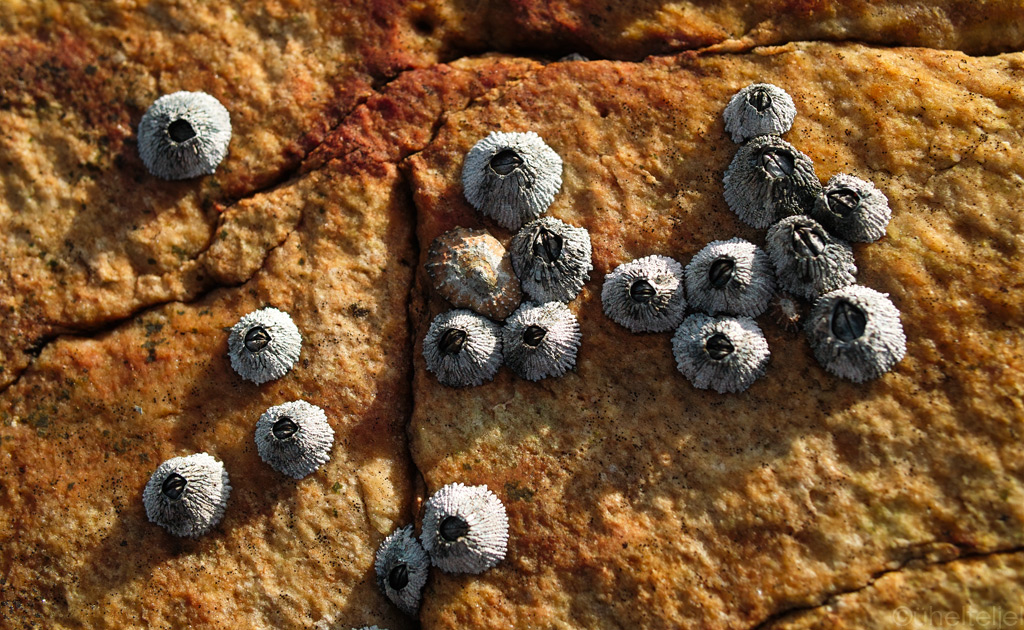
Almost like miniature volcanic mountains...
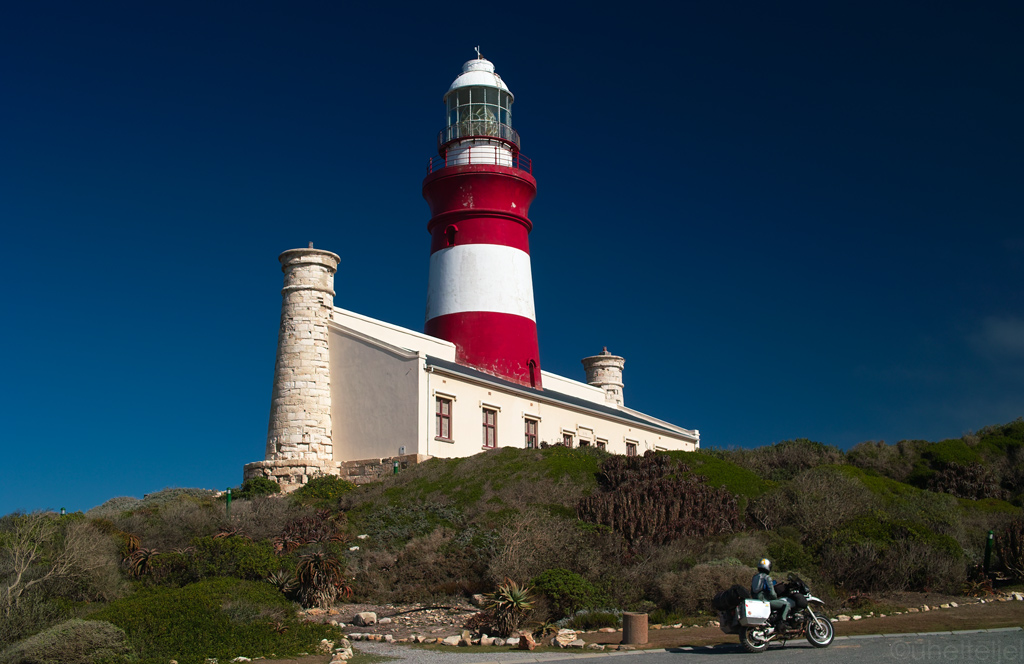
Under the Cape Agulhas lighthouse - second oldest in South Africa.
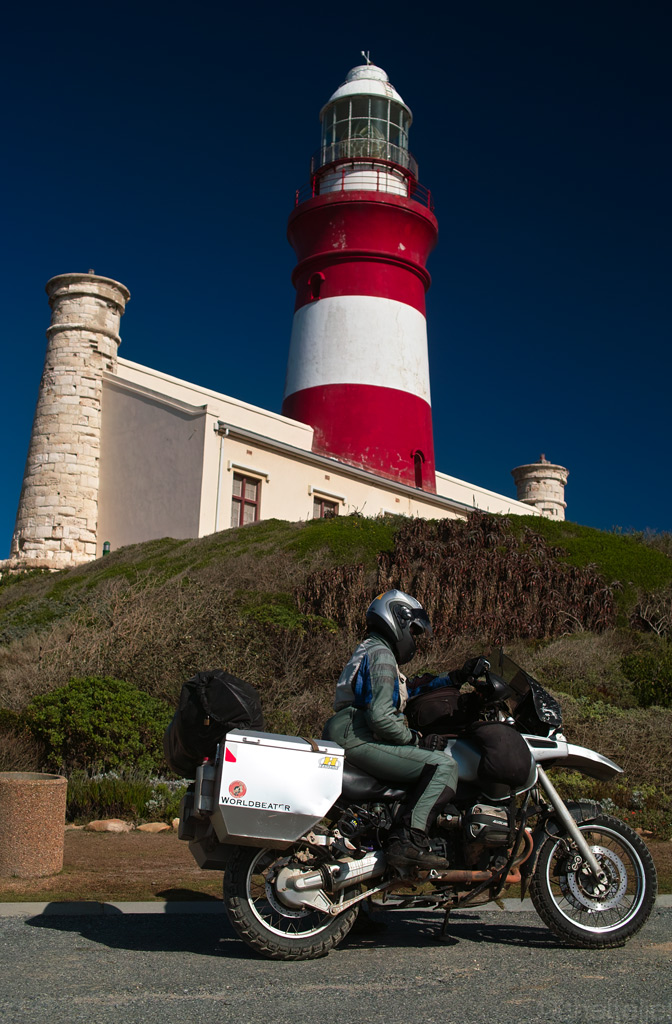
Closer.
In Cape Agulhas we caught some intriguing radio signals, one of them at 5998KHz, probably communication between lighthouses or ships going between the Indian and the Atlantic ocean?
...::: LISTEN :::...
And also long wave radio signals propagate over the Indian ocean, so we had a relatively good receiption of an Indian radio station bringing back some good memories from that particular country:
...::: LISTEN :::...
We did not spend too much time in Cape Town, although it proudly stands on many a traveller's final destination on their venture through Africa, something like a longing or a grand finale. For us it wasn't. We were there mainly for business - to apply for an Angolan visa which they say Cape Town is the most likely place to get one. Meanwhile we saw a little of the legend, but maybe it was because it was so little that we could not really appreciate what it had. It was very civilised though, so you could almost have it mixed up with some cities in the Old World, but somehow we missed that special something.
Or maybe not… While trying to find some space to park in the city centre, a guy called Stefan (if you happen to be reading this, please correct us if the spelling is wrong!) came talking to us, saying that he had been following us on ADVrider. Then he went and came back in a little while, and… put some money in my hand. It is only later that we counted the money and found it to be a considerable amount. We really felt humbled. Thank you Stefan!
And also, thanks to the anonymous guy in a Harley who rode past us on the N2 soon after Tsitsikamma National Park whom we caught again in a toll station queue and who waved us to pass him as he had paid the toll for us. Totally unexpected and absolutely heart warming!
South African biking community has received us extremely well, sending us invitation letters, providing us with food, shelter and heaps of useful information, and just being there for us. A great bunch of people. Thank you Ian, Conrad, Steve, Michnus, Elsebie, Donald, Charl and Sean!
But back to Cape Town. Considering the geography, we would have expected to find something similar to Rio de Janeiro, with all the sea and mountains. But it wasn't there. Maybe it just lacked the samba and the bossa nova, I don't know. Or was it that our minds were too much occupied with more mundane subjects such as the visas. Yeah, the Angolan visas. Hard to get and expensive. We'd go around that country if we could, but the only viable option would mean shipping the bike, and this does not sound interesting. So as soon as we hit Cape Town we headed to the consulate, where once again we were convinced that it would take a lot of money, paperwork and patience. In that order.
The money was perhaps the easiest, although not really painless - around 100 EUR per person for the 30-day visa. Not the cheapest, but hey, not the most expensive visa we've had so far either.
The paperwork was a headache, because unless you are applying for a five-day transit visa (which, considering the sheer size of Angola, is not impossible, but very tight, especially in the rainy season which has already begun) you need an invitation letter from an Angolan citizen/entity that has to be notarized and sent to the consulate from Angola. Finding a friend in Angola was not difficult as we had met in Nairobi a Portuguese guy called Gonçalo who had been working in Angola for quite while and was then travelling through Africa on his R1100GS, so he has some contacts. Notarizing the letter wasn't too difficult, but finding a fax in Angola… oh well, it obviously took days, but the consulate would not accept anything but a fax from Angola. Who would have imagined that even Angola has switched to internet by now, except for their foreign representation In addition to the invitation letter we took along multiple copies of our bike's registration, my drivers licence and the Carnet (because we do not have any flight tickets to show), yellow fever certificates and an explanation letter about the motives of our trip in Portuguese (because it's an official language in Angola, just like in Mozambique). When we got to the consulate with our filled-in applications they just frowned upon them because they were filled in with blue ink, but they wanted it to be black ink. So we had to do it again. In two hours at the consulate we had finally managed to get our applications in.
In addition to the invitation letter we took along multiple copies of our bike's registration, my drivers licence and the Carnet (because we do not have any flight tickets to show), yellow fever certificates and an explanation letter about the motives of our trip in Portuguese (because it's an official language in Angola, just like in Mozambique). When we got to the consulate with our filled-in applications they just frowned upon them because they were filled in with blue ink, but they wanted it to be black ink. So we had to do it again. In two hours at the consulate we had finally managed to get our applications in.
We were told it would take 7-10 working days to have the applications processed. A long and nerv wrecking wait… Thanks to Donald and his kids who hosted us in Cape Town it wasn't that painful to get organized.
Not to become too frustrated while waiting we decided to play tourist a little and headed to Cape Peninsula just south of Cape Town. It was soon clear that it was not only us that had come to play tourist there as there were busloads of people there trying to fight off the ferocious winds while posing with various landmarks. But the landscape was truly fine, so no complaints.
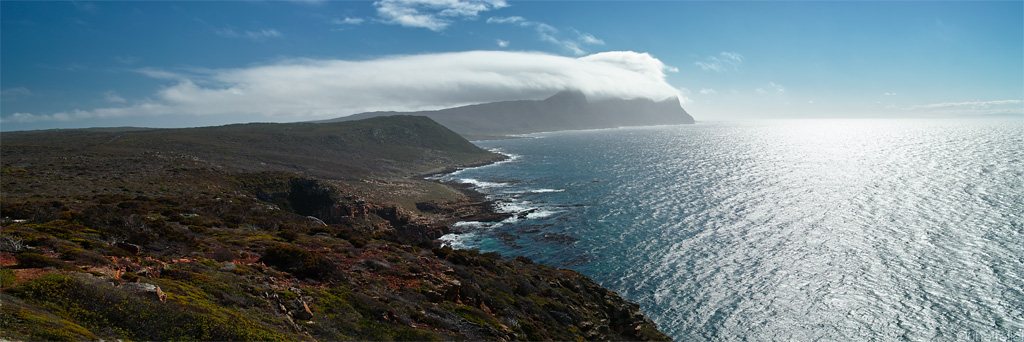
Panorama from Cape Peninsula (click to enlarge)

Wider panorama (click to enlarge)
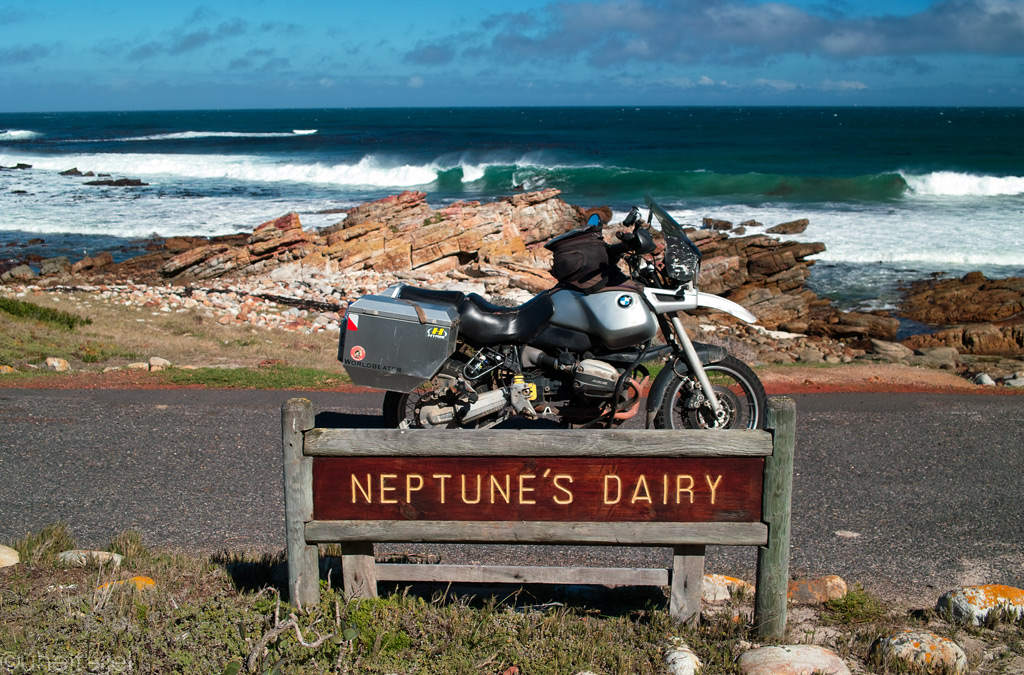
The bays had funky names - Neptune's Dairy.
It was, of course, nothing more than a one-day, or even a half-a-day ride, so it was not nearly enough to get our minds off the visas. So we took the decision to head out to Karoo which is basically a huge semidesert - huge enough to get lost for as many days as you could possibly like. We'd heard it would be something like central Australia where you can ride for hundreds of kilometers without seeing another vehicle and where the stars are particularly bright at night. The southern edge of Karoo is more mountainous and home to countless vineyards, so it seemed only logical to start from there.
Riding the roads in the Klein-Karoo, or Small-Karoo as this area is often referred to, offered a complete change of scenery, way of life and mindset from the bustle of a metropolis like Cape Town. Here too it was difficult to understand that it is actually Africa - the Old World style wine cellars and road houses, pubs like out of a Western looked and felt totally un-African. And the wine! What could be better than to open a bottle of nice local wine and to thing that regardless of all the trouble and uncertainty, life wasn't so bad.
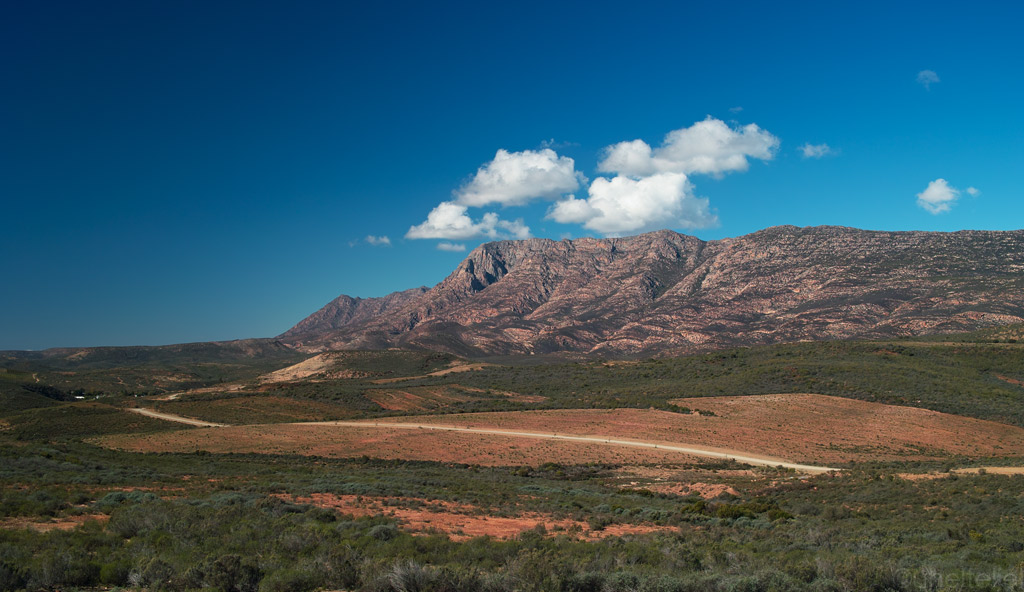
The beginning of Karoo desert
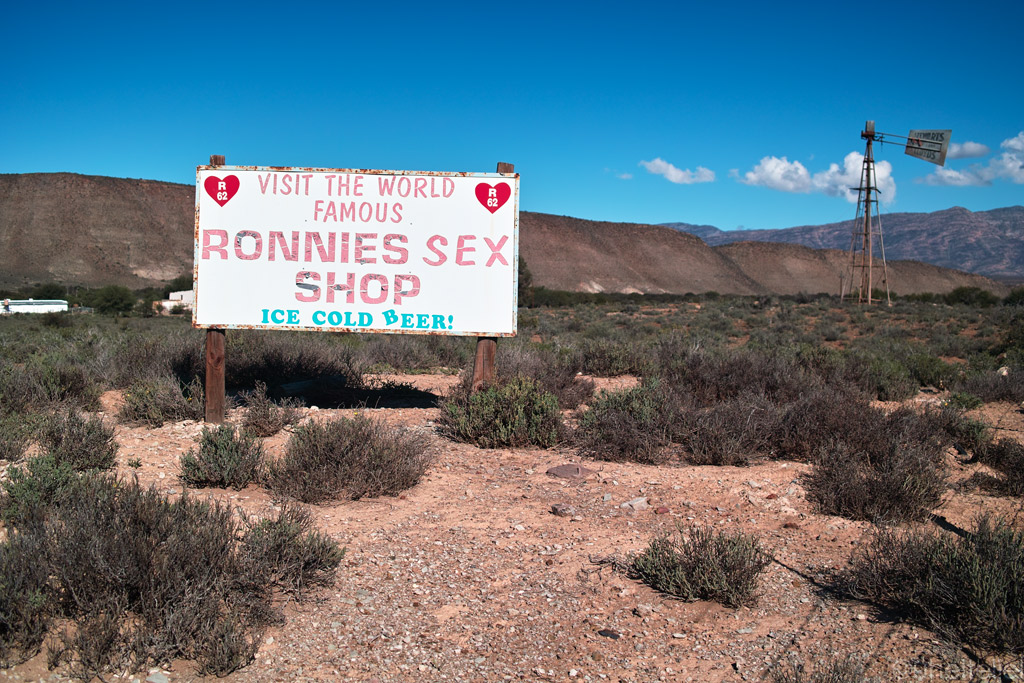
Ronnies sex shop - actually it's just a pub.
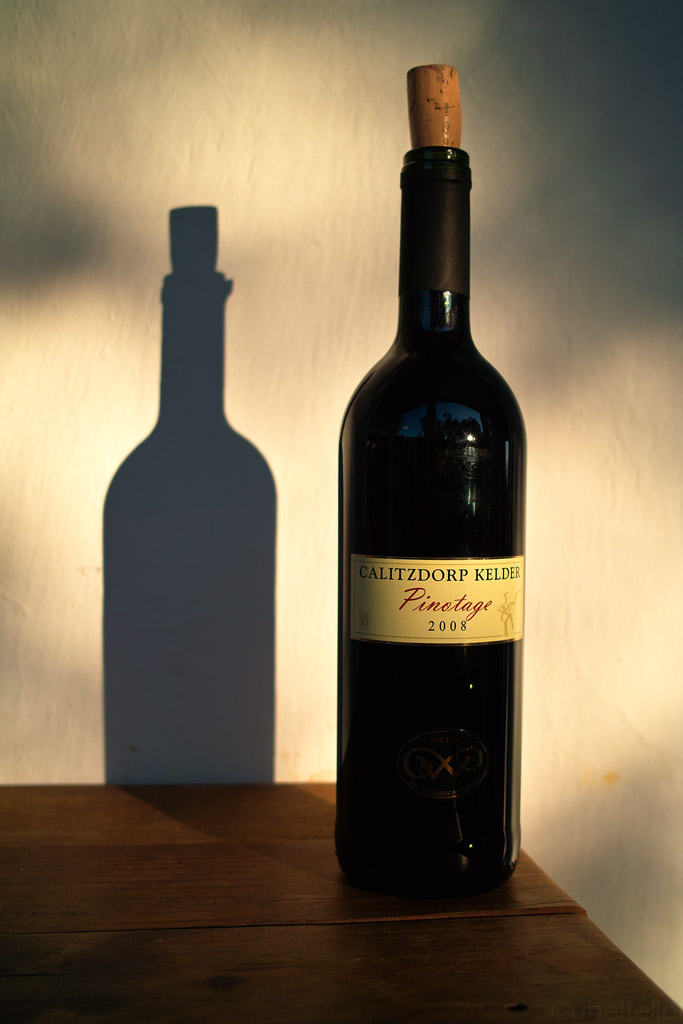
Good South African wine to acompany us in the evening.
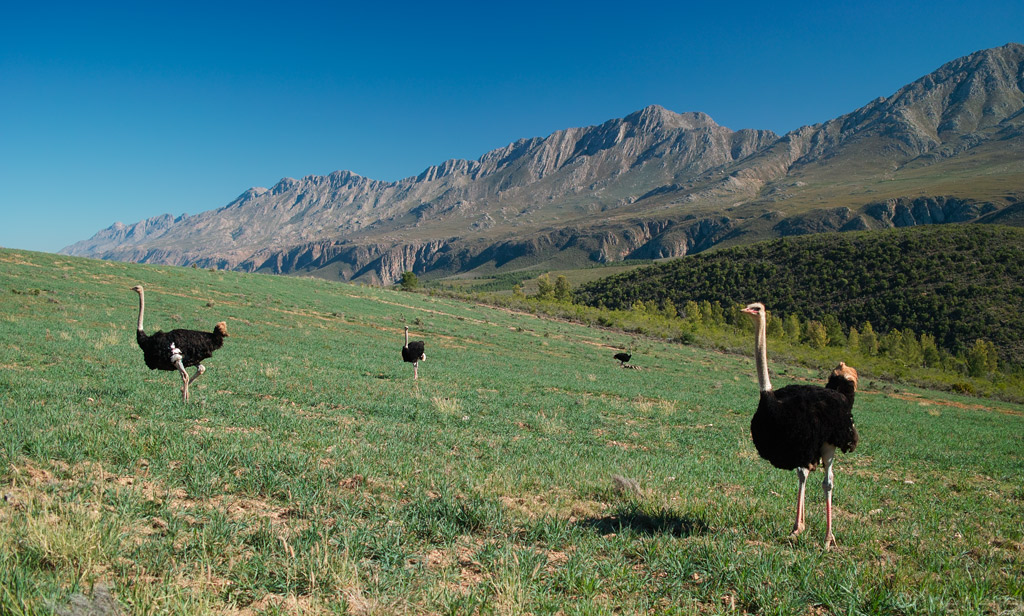
Ostriches.
One of the great highlights of the Small Karoo was the Swartberg pass across a mountain range with the same name. Truly spectacular, and offering a different perspective every 100 meters!

Panorama of Karoo near Swartberg pass (click to enlarge)

Panorama of Swartberg pass.

Panorama of mountanous Karoo.

Panorama from the road to Swartberg pass.
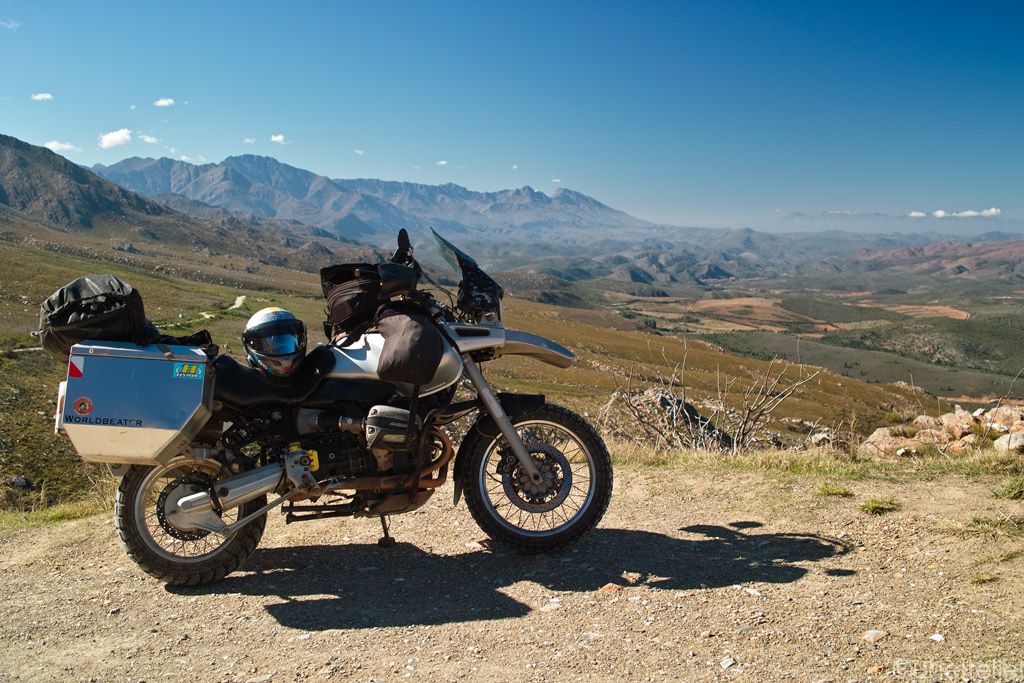
Climbing higher.
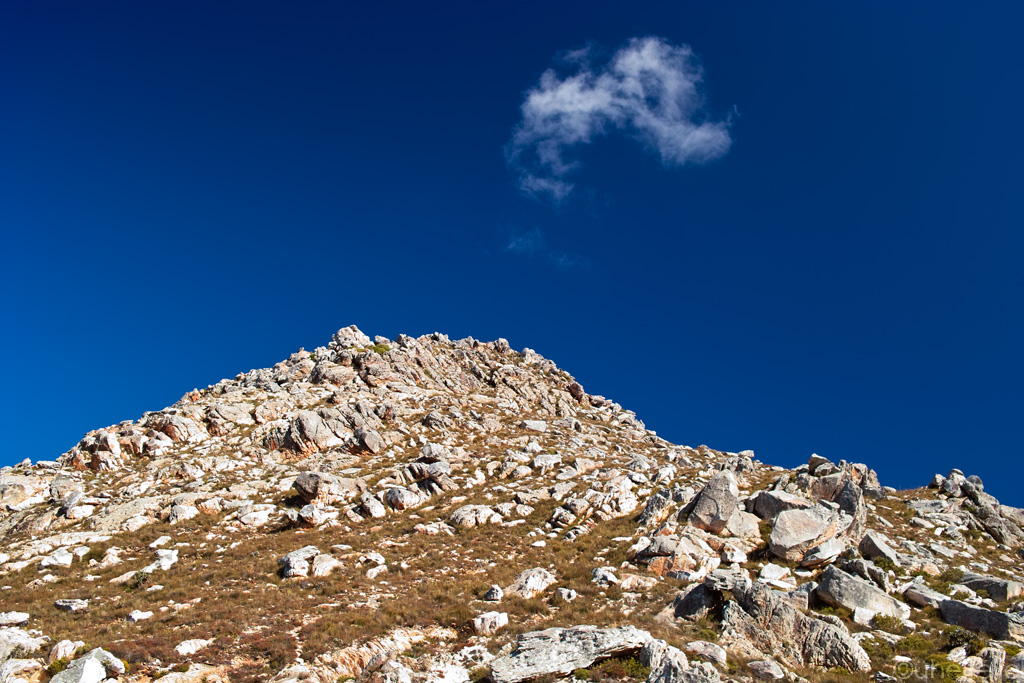
Mountain top in Karoo desert.
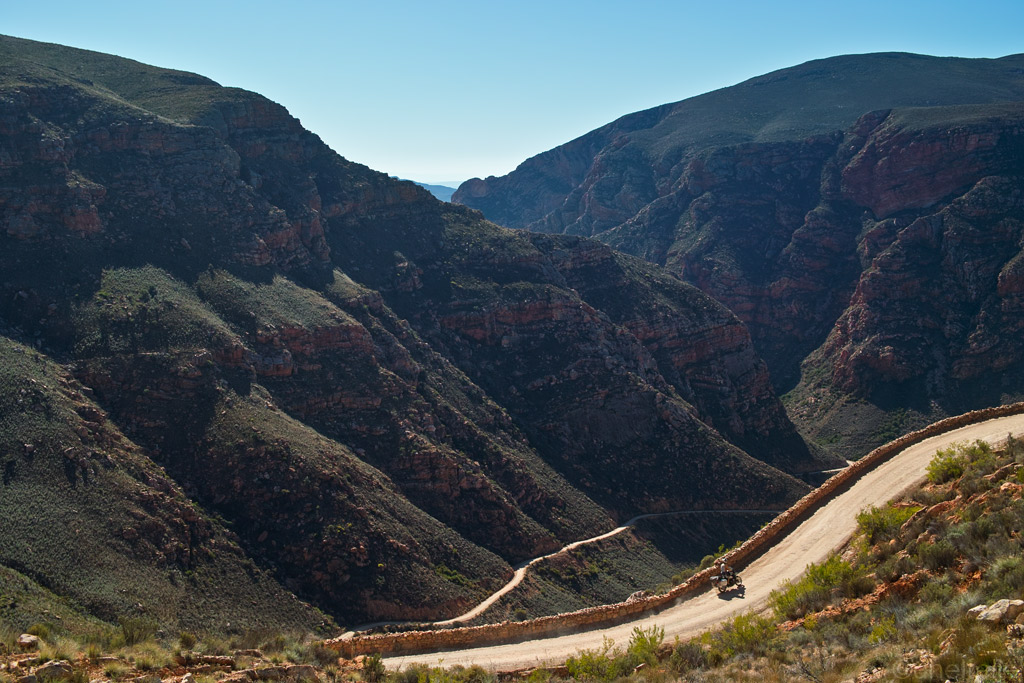
Crossing the Swartberg pass.
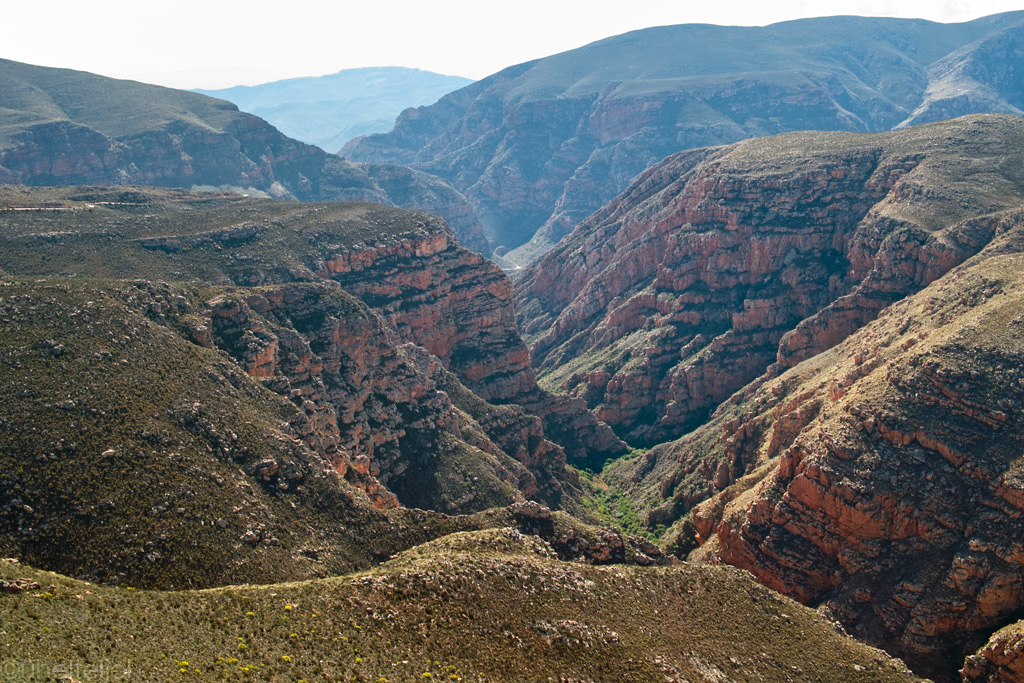
A canyon in Karoo.
Once we'd crossed the Swartberg Pass, there was a great change in scenery. We were in the Great Karoo. Broad, empty, lonely, full of power. No people, no cars, only a few lonesome sheep farms dotting the far horizon, with huge windpowered water pumps making slow, tired, squeaky turns. It would be great to life here for a while to let the thoughts to settle and to let the soul cool down.
We had quite a ride in the Great Karoo, without any specific plans or destinations, taking random tracks and just riding, taking in all that the journey had to offer. Hundreds of kilometers of gravel, revealing a new sight, a new formation behind every corner. Mountains in the morning mist, half dreamy half forgetful desert, a track running between rocks radiating the suffocating heat they'd accumulated. Just as if the time had stopped, and for us it had, because we could not care less if it was morning or evening. We just lingered.
By the end of the day we'd always manage to find a campsite (unfortunately, all the roadside is fenced in South Africa so you'd be lucky to find a spot for bush camping - I do not know if it is for the wild animals orif it is someone's private property) and enjoy the view of the stars in the Southern sky with a bottle of local wine. No, really, it would be great to live here for a while…

Typical Karoo landscape in panorama (click to enlarge each one)

Panorama from the road through Karoo National park.

Karoo landscape panorama.
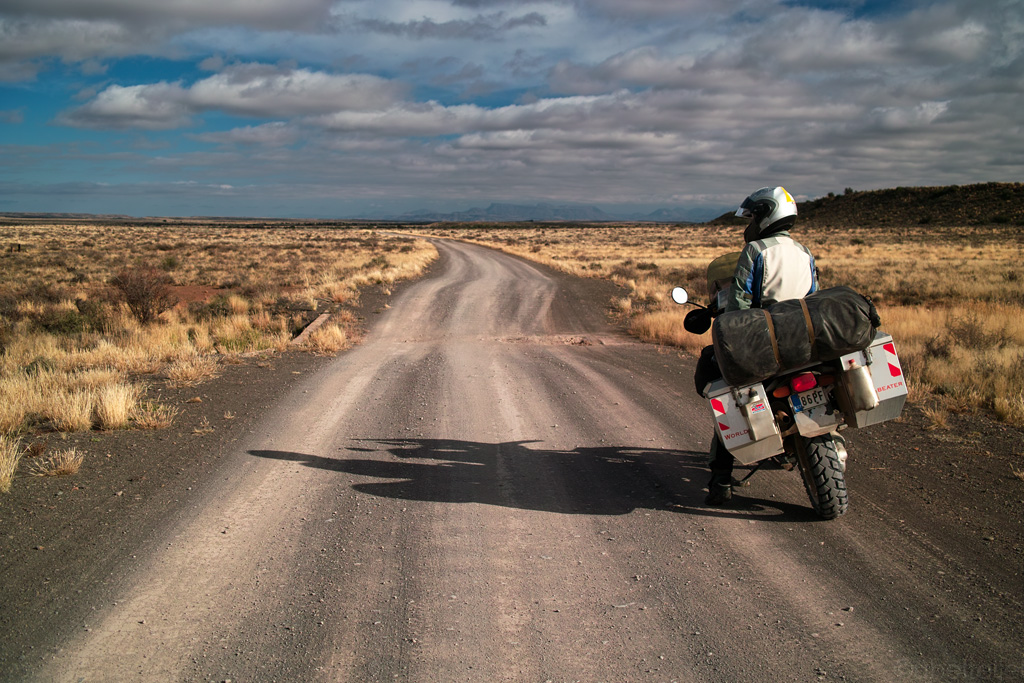
Road through Karoo National park.
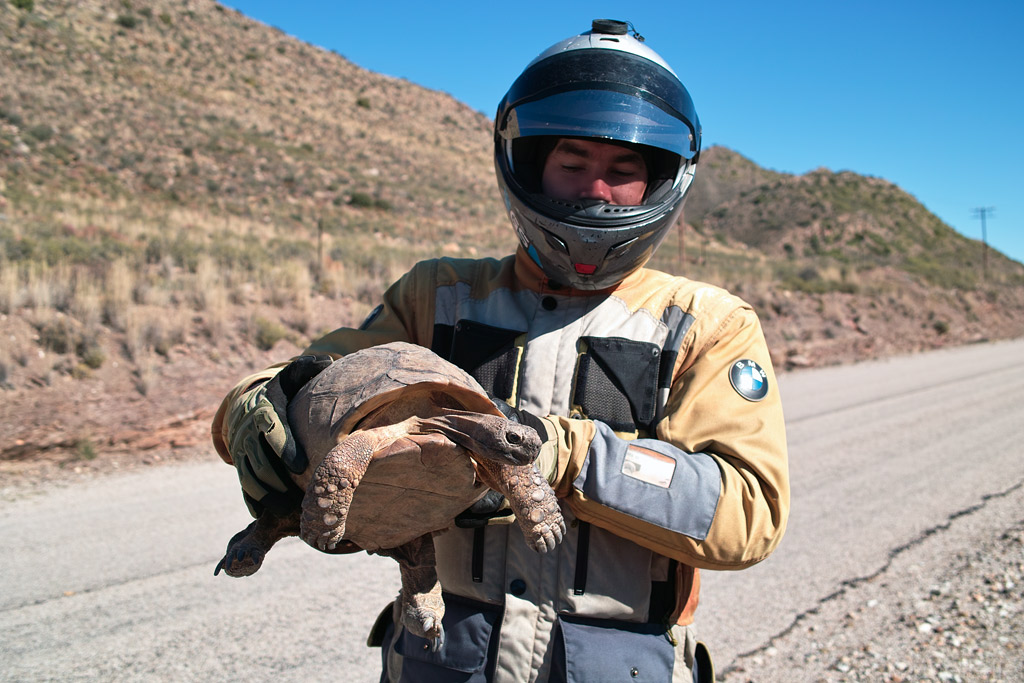
Helping a tortoise off the road.
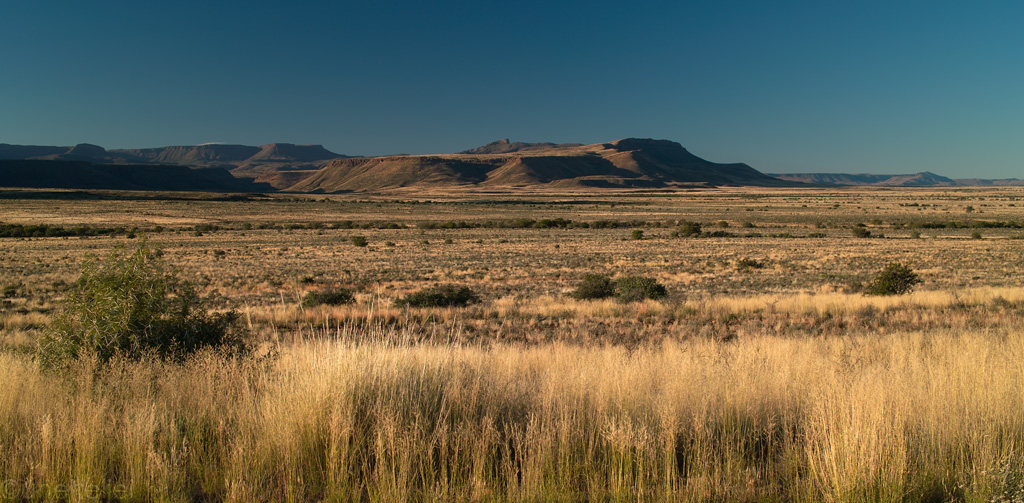
Karoo colors.
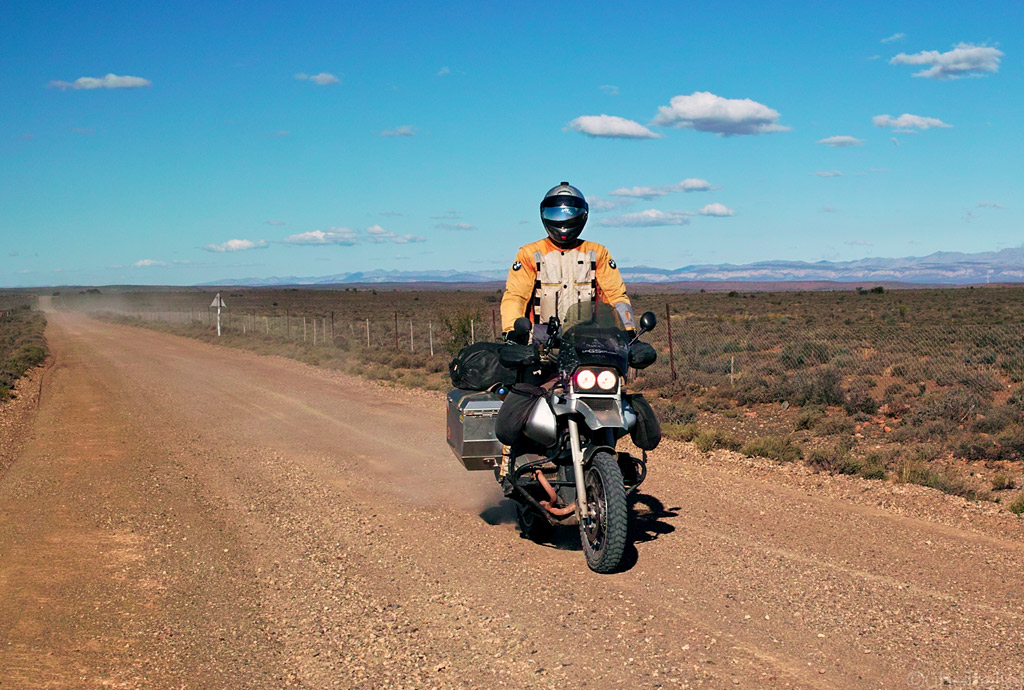
Typical Karoo roads - all fenced by farmers.
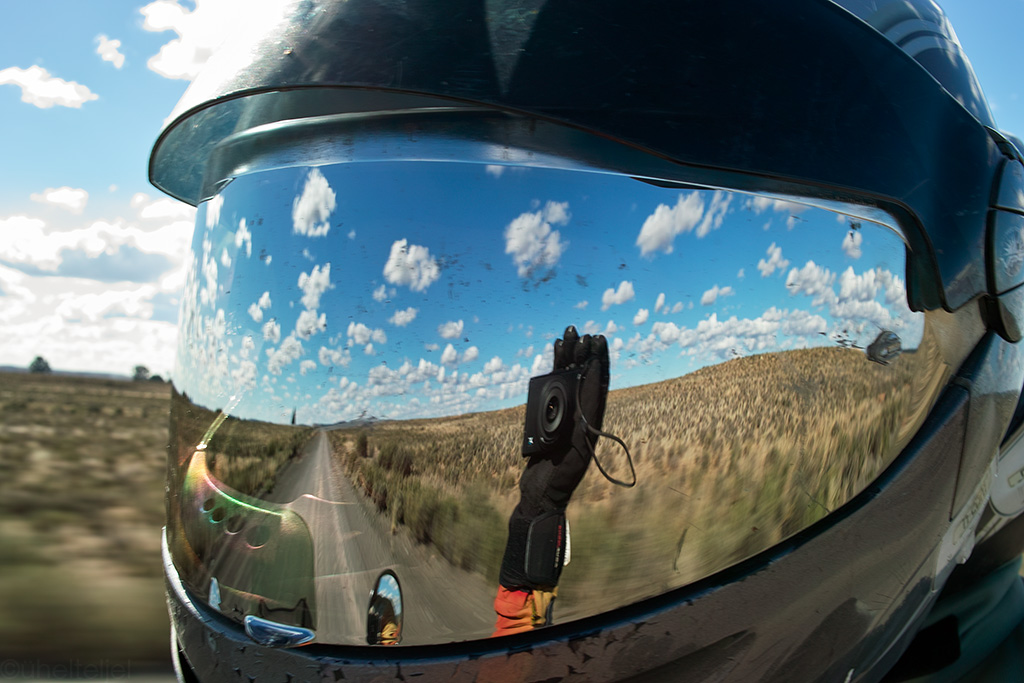
Autoportrait of Tsiklonaut.
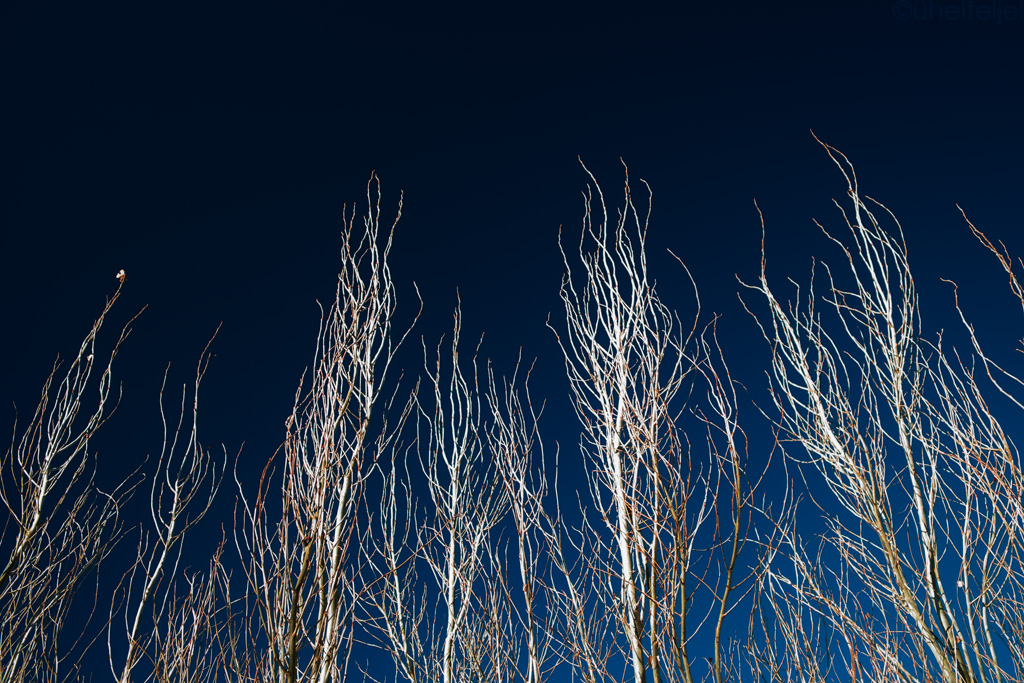
Leaveless trees in Karoo.
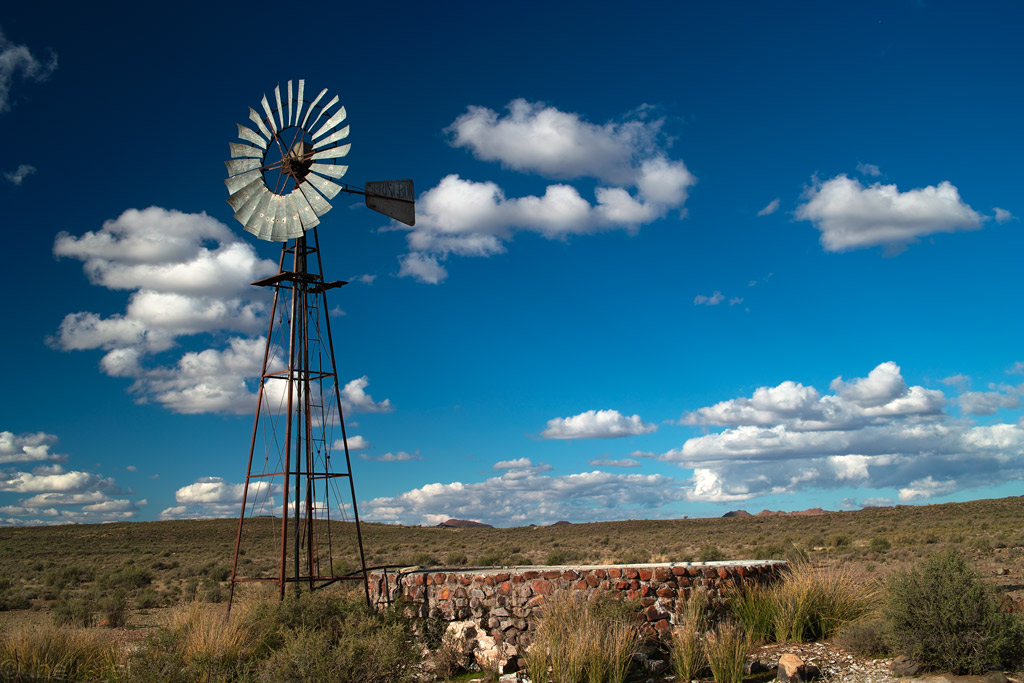
Wind operated waterpump - same like in Australia.
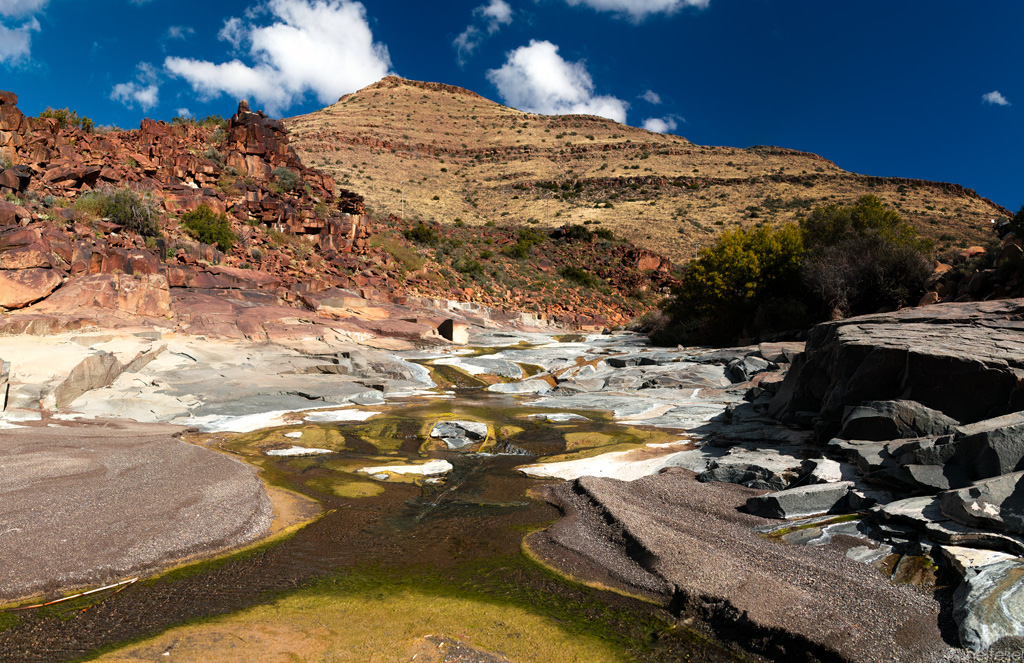
A riverbed in the Karoo.
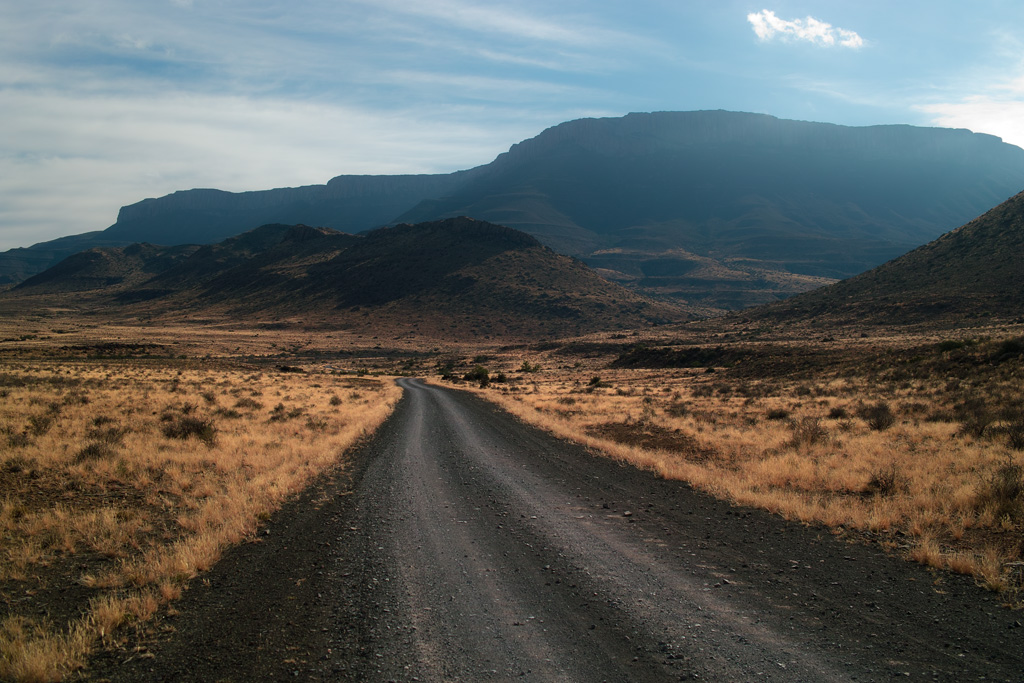
Road...
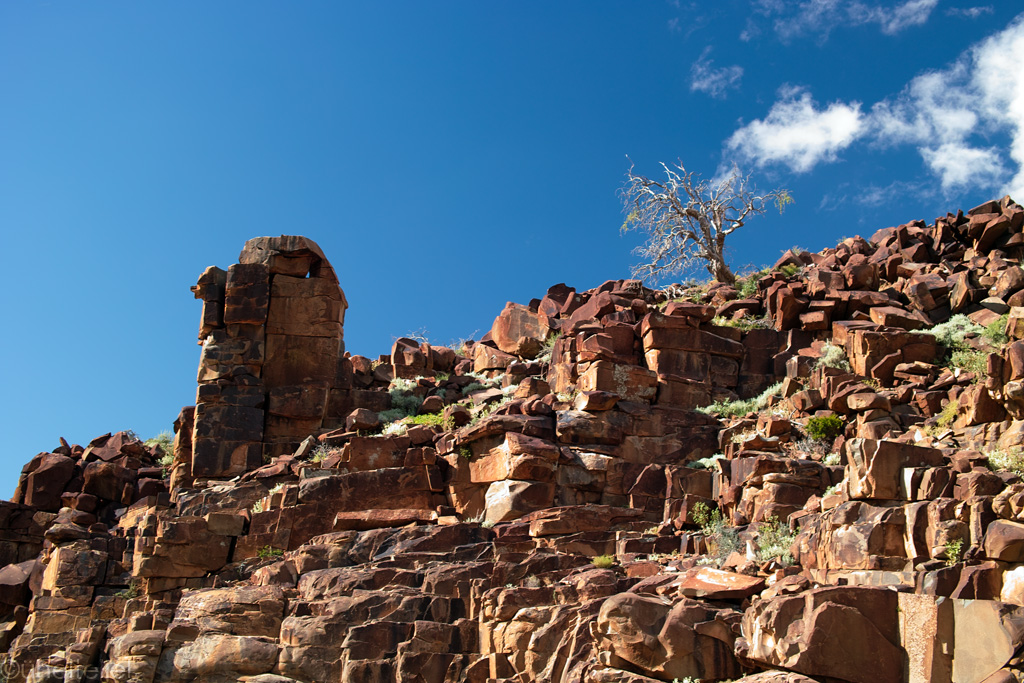
Karoo rocky landscape with a lone tree.
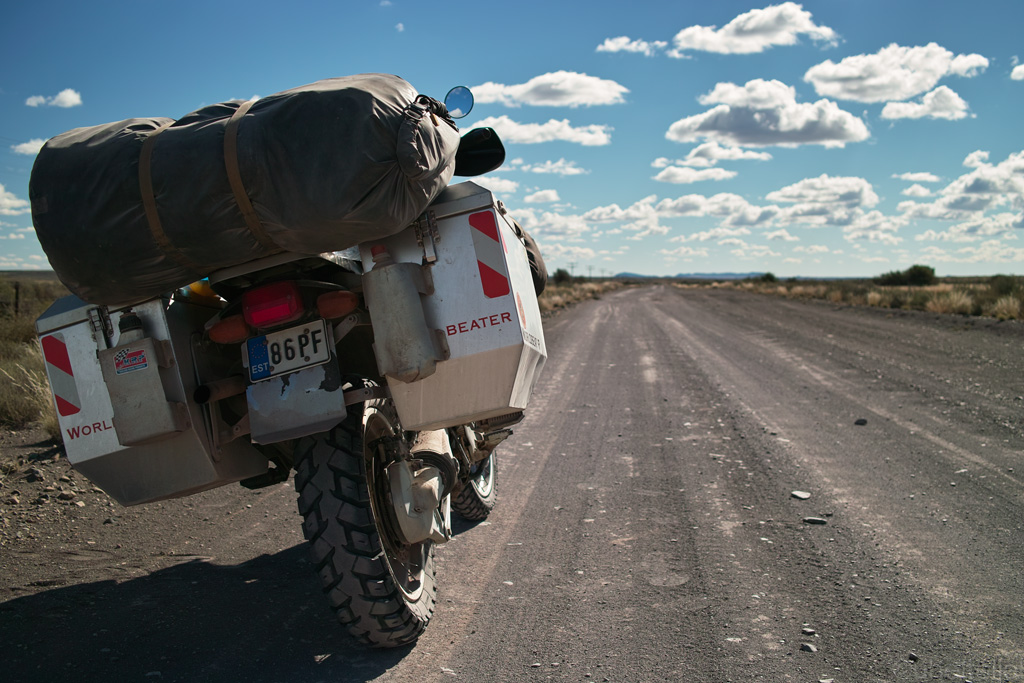
Picture from the road.
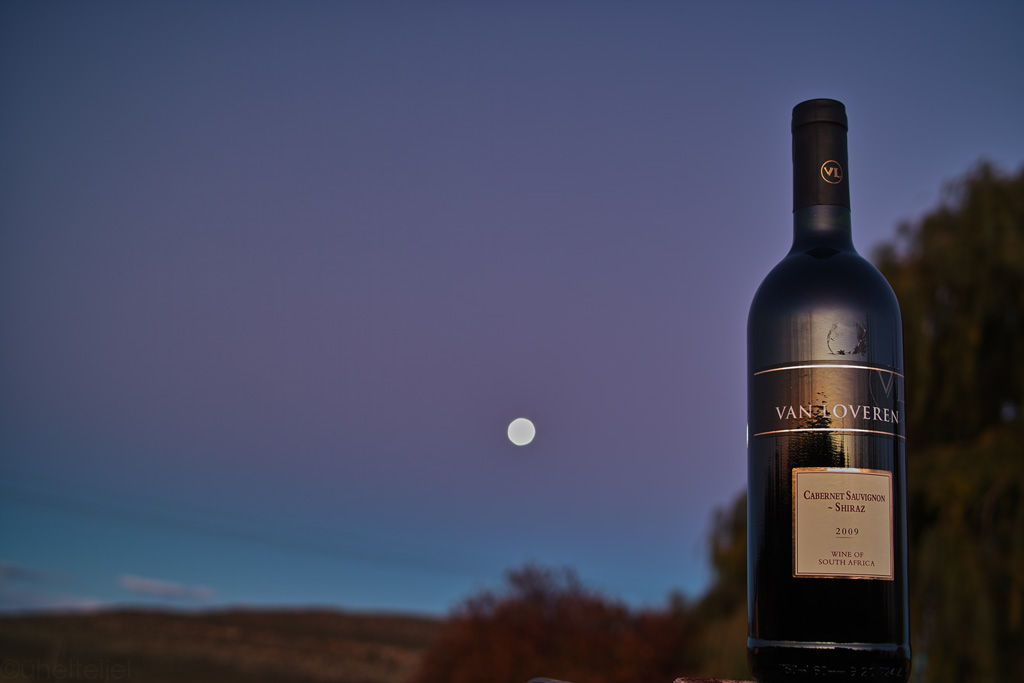
Tasting South-African wines in the moonlight... All local stuff.
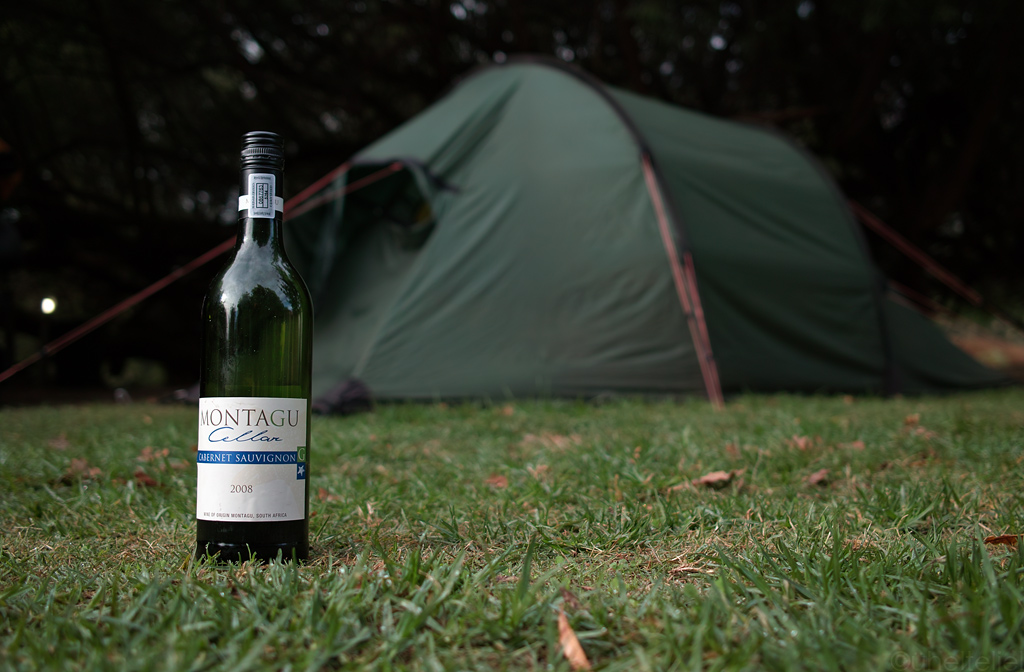
While in Montagu we drink the wine accordingly.
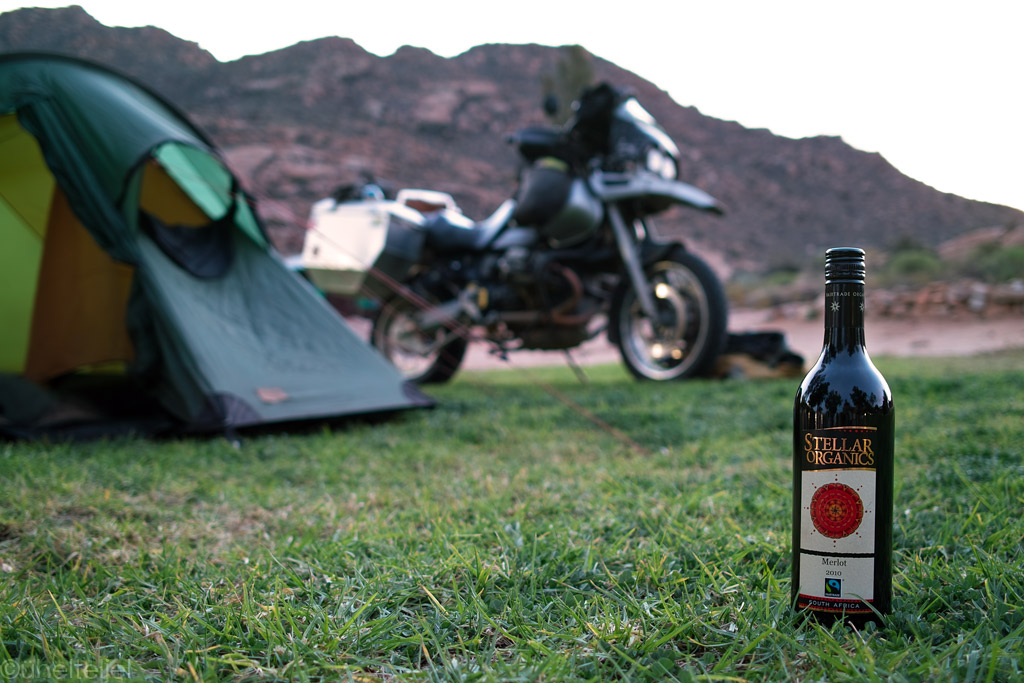
Since we had stellar ideas, a proper wine had to accompany them.
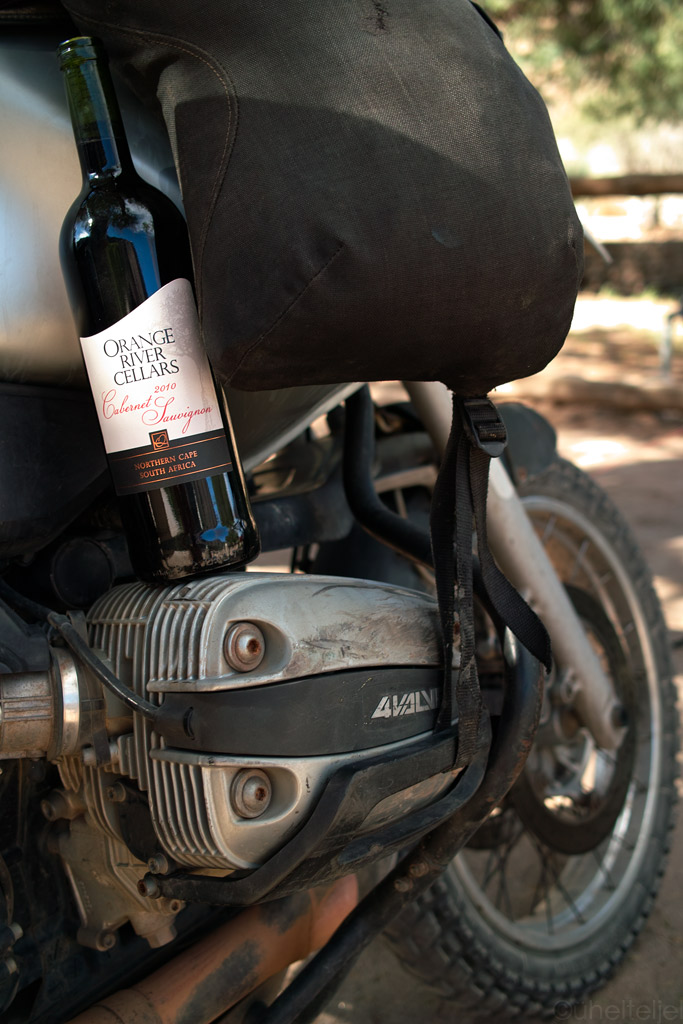
Close to Orange River we had a bottle of proper wine as well.
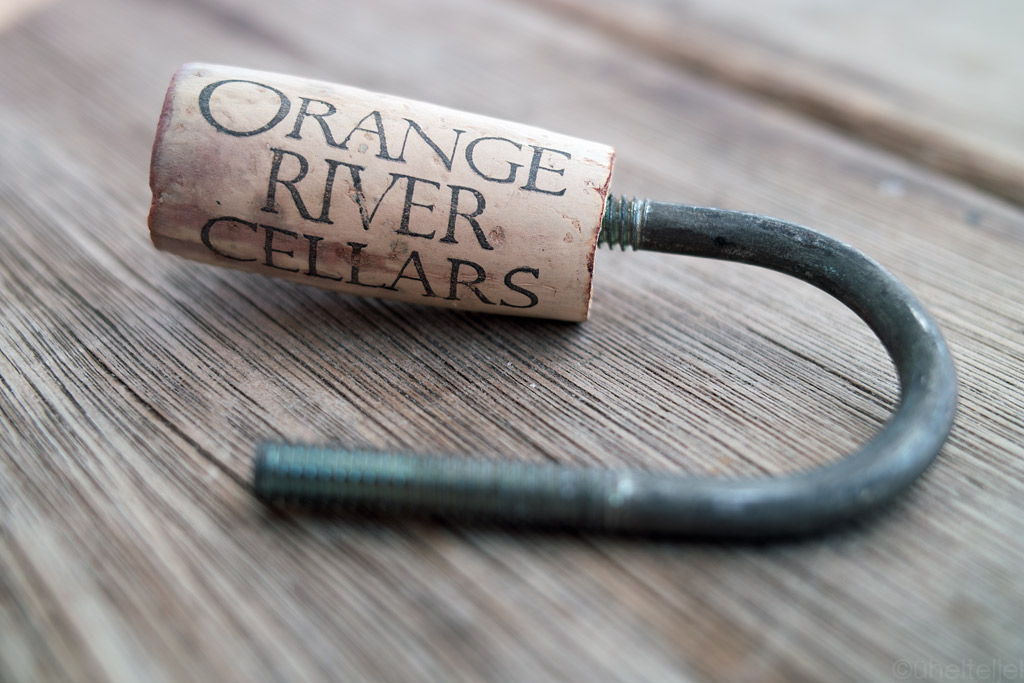
Since we don't carry a wine bottle opener we used more creative methods - GPS mount's spare U-bit.
The gravel tracks in the Karoo are a little shrewd though - most of the time one can go as fast as 120 km/h, the dust flying high behind, but there are some treacherous rust going across the road that one often notices only when it is already too late. Sure enough we went through at one of those at a great speed, the wheels lifting off the ground and the bike making a crashing sound as if it was about to break in half. At first inspection of the bike all seemed allright, but at one point we discovered that the bolt that is keeping the shock in place from the bottom looked funny, just as if it had come half loose. Who knows how long it had been like that. So I tightened it and rode on a little worried, because riding with a loose bolt can create abnormal tensions in the shock, and this is not good.
As we arrived in Sutherland we looked up a workshop, hoping to straighten up the bolt that we believed must have been bent, or to replace it, but as I tried unscrewing it, it became apparent that the bolt was not bent, but actually broken in two. It was a miracle we'd come so far with a broken bolt. We installed a new one, but I also had to bend the shock mount a little as it had been bent a little too because of the loose bolt. I am pretty sure it affects its strength too, so we really have to be careful from now on not to break the mount in tough conditions. Considering our shocks have all had some sort of curse placed on them, we would not be surprised if something went terribly wrong again. We are keeping our fingers crossed. If the shock blows I'm afraid it will not be the shock that we'll be shipping to Europe for repairs, but the whole bike and ourselves too. Counting the cents, there just isn't any space for mistakes left here on our journey back.
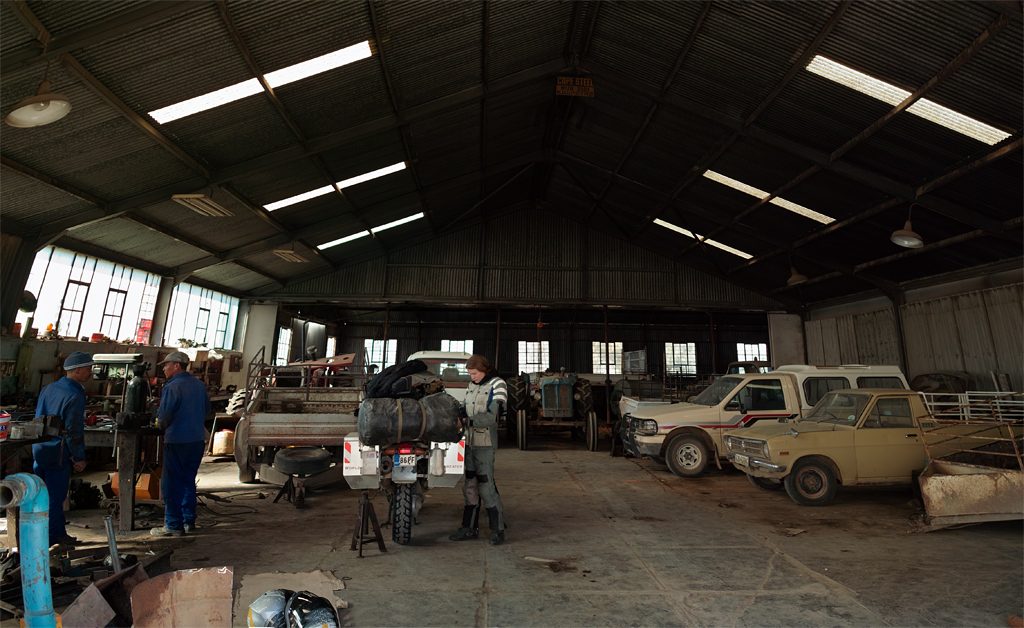
In the workshop in Sutherland - trying to reweld the sidestand and fix the suspension bolt.
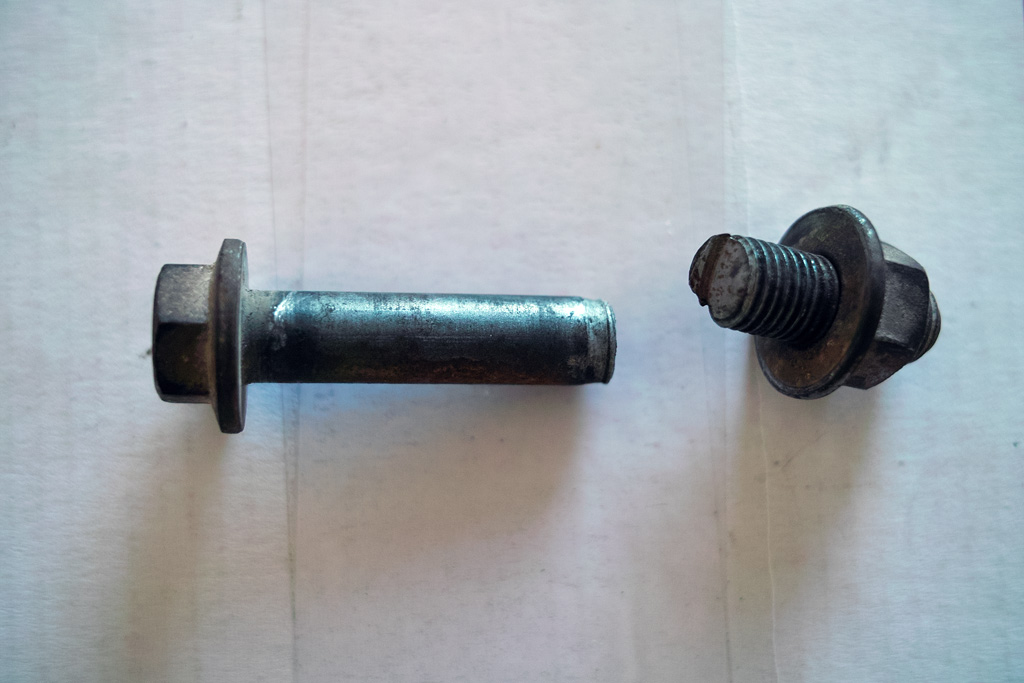
Turned out the bolt had split into two! Through some magic it had carried us there.
The side stand, too, gave up while in the Great Karoo, the tiny little wire holding the springs just braking off the side stand. So before we arrived in Sutherland where we could get it welded, we had to ride with the side stand literally tied to the bike. Strange how things tend to start falling apart at the same time. Or maybe it is the mileage. With 225 000 kilometers on the clock, and counting, it is really no surprise. Most of it has accumulated in dubious road conditions, and under dubious loads. Add to that all the heat, air polluton, low quality olis and fuel, and… a combination that 99% of the GSes never see. Just keep our fingers crossed that this beast would take us home, back to Europe - it's a long way.
The Karoo is also home to the SAAO or the South African Astronomical Observatory, the biggest astronomical observatory on the whole continent. And to be totally honest, it was one of our main interests for visiting the Karoo in the firts place. Although not a tourist site as such, it is still possible to go to see the facility with a guide - an opportuity we could not miss.
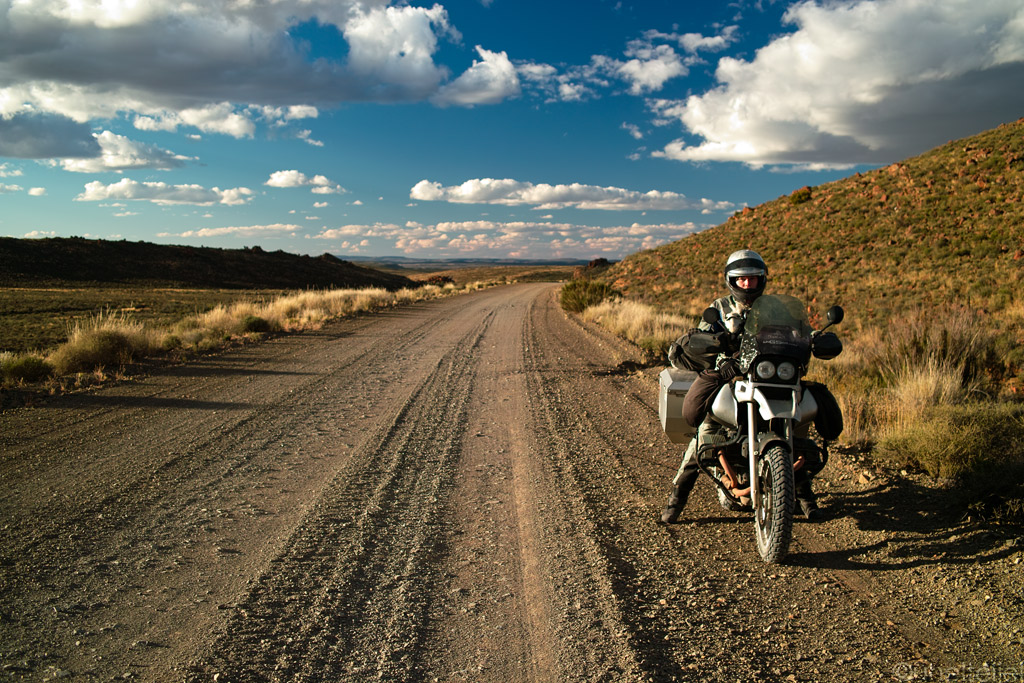
Approaching to South African Astronomical Observatory - height is already 1700 meters above sealevel.
In addition to different telescopes there is a small exhibition explaning the functioning principles of spectrometers - the main tool in astronomy, and also featuring all sorts of other equipment and some fabulous photos of the distant corners of Time Space.
We got to see the Radcliffe telescope, which with its 1,9-metre main mirror was, until 2004, the largest in South Africa. Also interesting was BiSON (Birmingham Solar Oscillations Network) observing - surprisingly - the nearest of all stars - the Sun. What was especially interesting was that it is remote-controlled from England. So much about the romantic understanding of an astronomer's work - gazing at the stars through a telescope. This is distant past. Today all the data gathered through the telescopes goes to the computer which makes a whole lot of equations and draws a picture as a result. Or even not that much - rather it is the quantifiable characteristics of the stars that we are looking at now rather than the stars themselves.
We also got to see the SALT or the South African Large Telescope. With its 11-meter mosaic mirror, all the fine tuning, adaptiv optics and calibration it is a true monster telescope - and so far the largest single telescope on the Southern Hemisphere. Works well to explore in more detail such distant and old sections of the Universe like the quasars.
So in total there was a lot to see with all the robotic telescopes searching for extrasolar planets, and also the geodynamic equipment and a lot more, that one day would not be enough to see and learn about everything.
The best part of the "tour" was when it was officially over and we could go and contemplate the facility on our own, and to think of how tiny we are indeed in the Metagalaxy both in terms of time and space, and to let the imagination roam free.
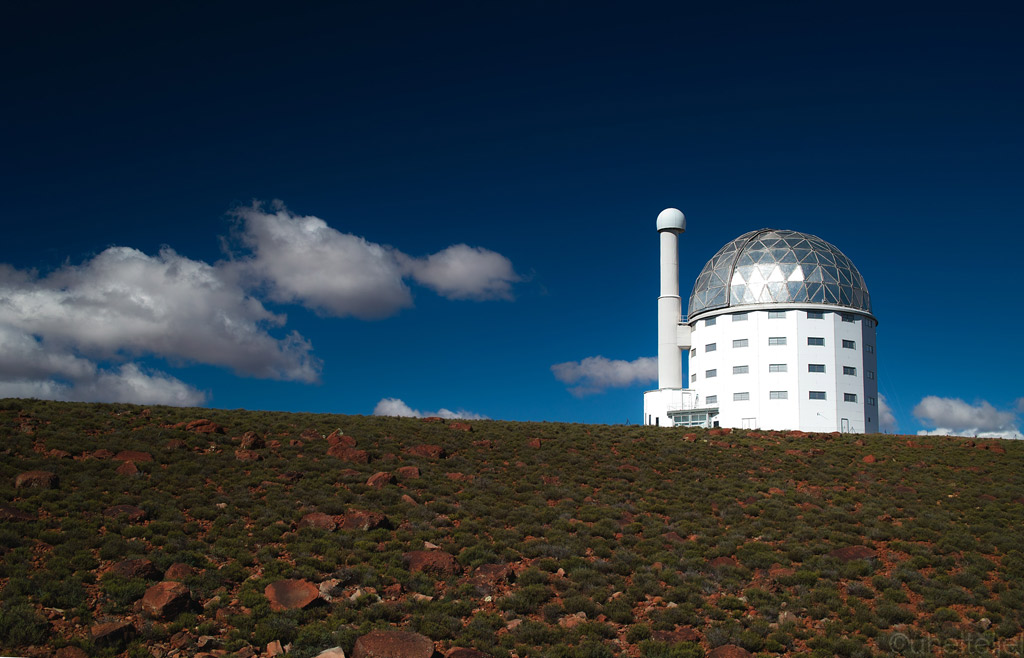
SALT (South African Large Telescope) - 11 meters of state of the art telescope sits inside it.
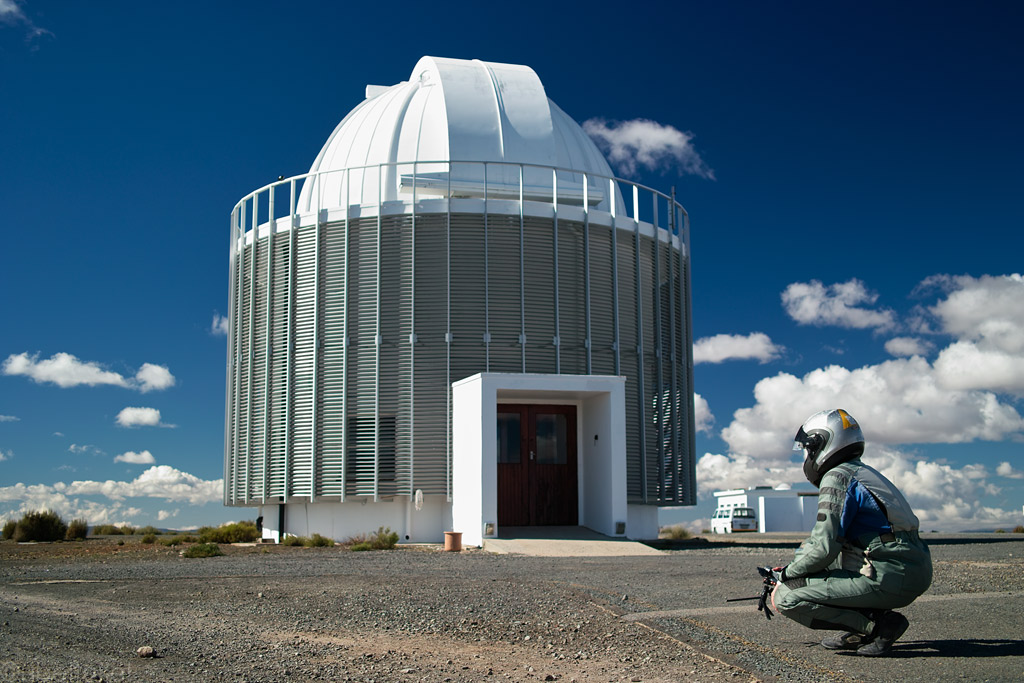
Kariina filming surroundings on the SAAO territory.
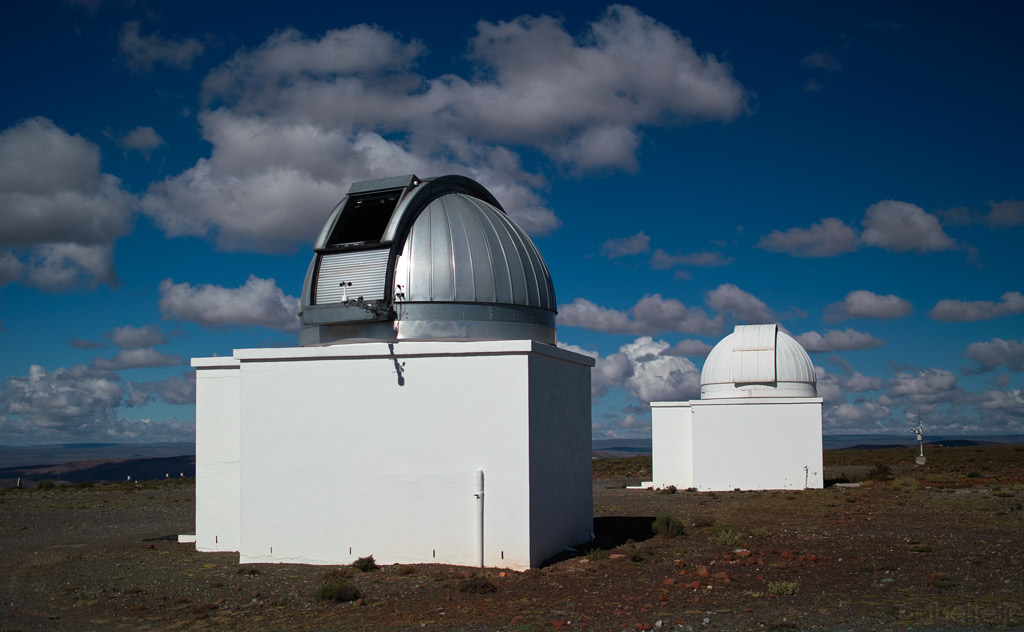
BiSON (Birmingham Solar Oscillations Network) is with open door during daylight - observing our nearest star - The Sun. It's remotely controlled real time from UK. A testament to the making of modern science.
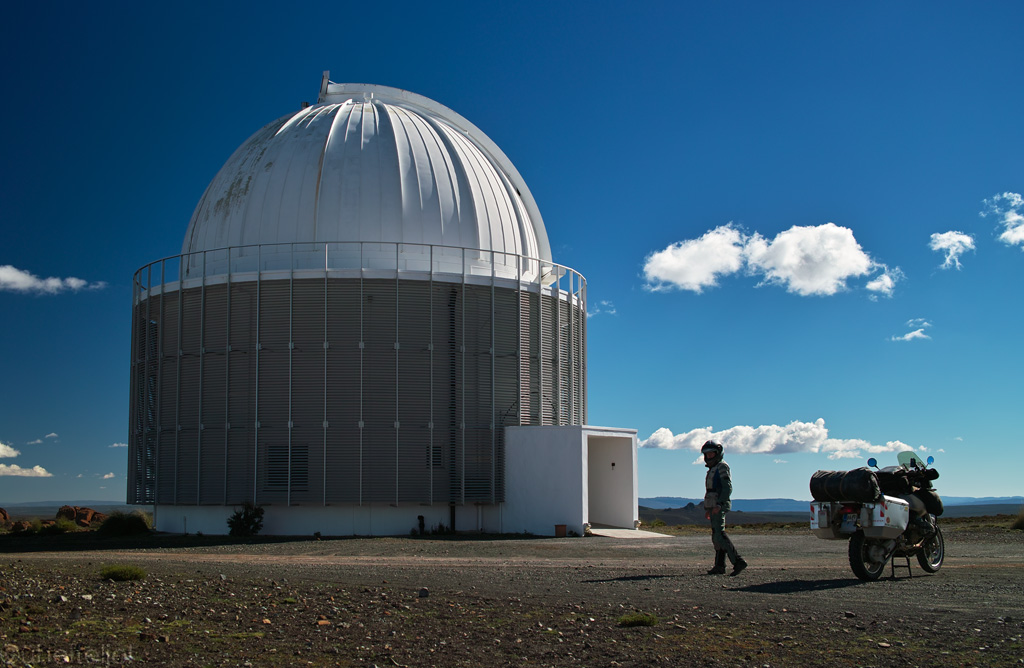
Seeing around SAAO with different telescopes.
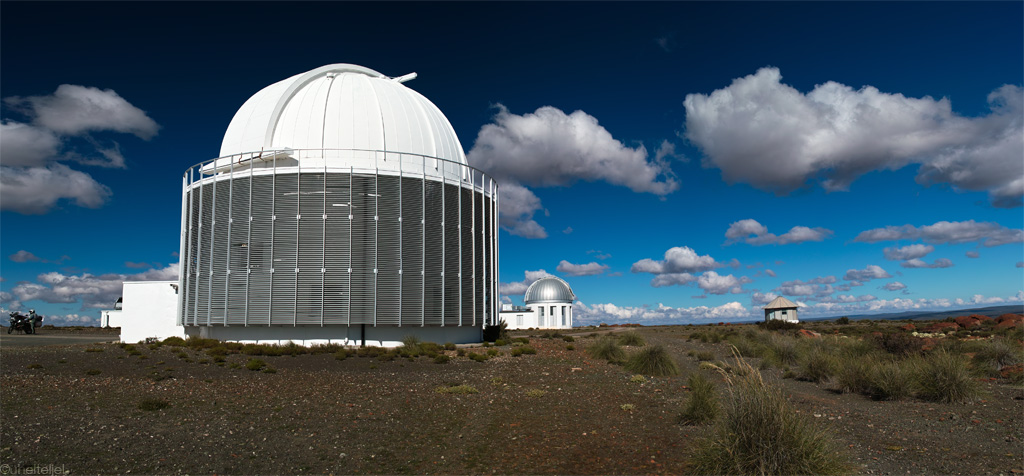
Panorma from 1.5 metre telescope surroundings.
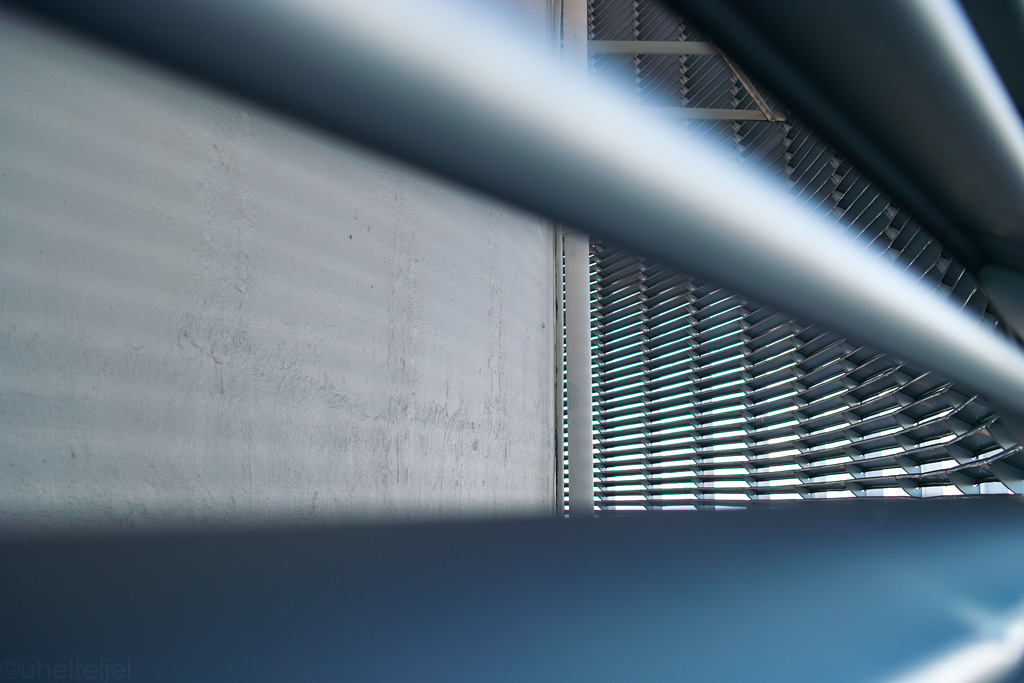
Many facilities are covered with special metal grille - improves thermodynamic stability inside where state of the art science equipment has to work.
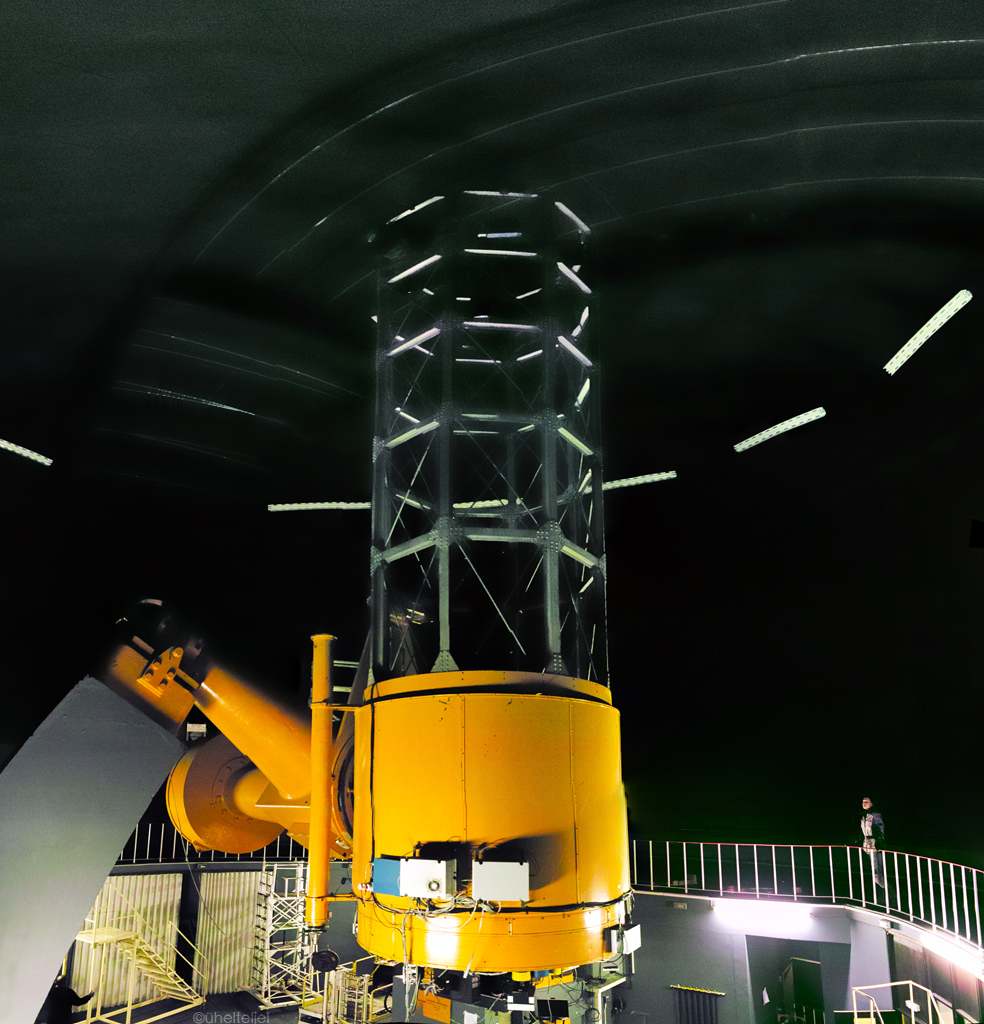
Radcliffe telescope (with 1.9 meter main mirror). See Kariina on right to get the sense how big it is.
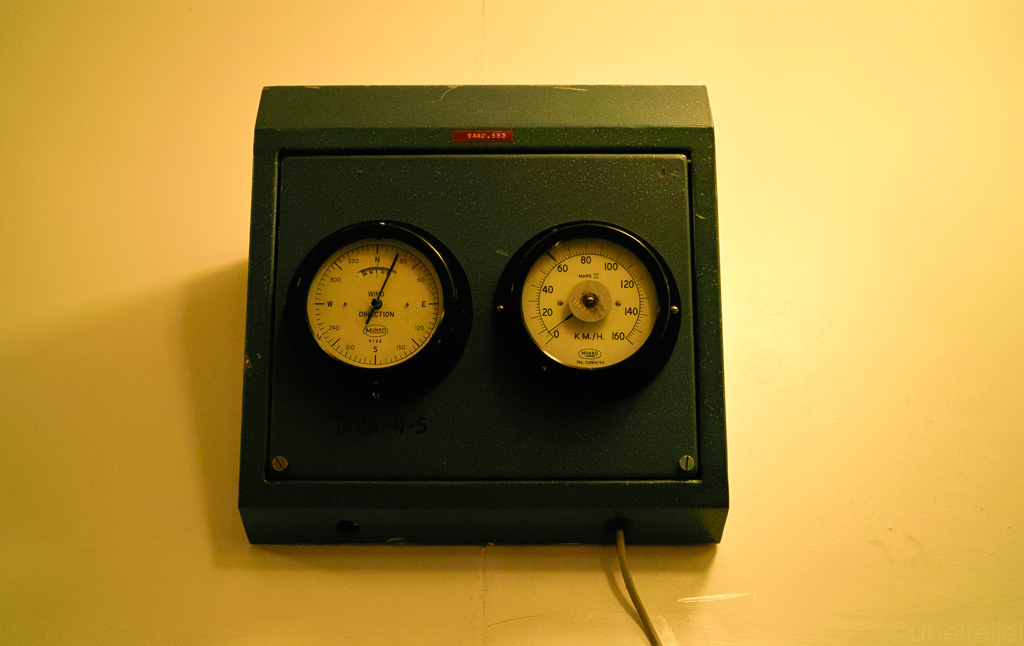
Wind direction and speed display - over 60kph winds the observations are stopped.
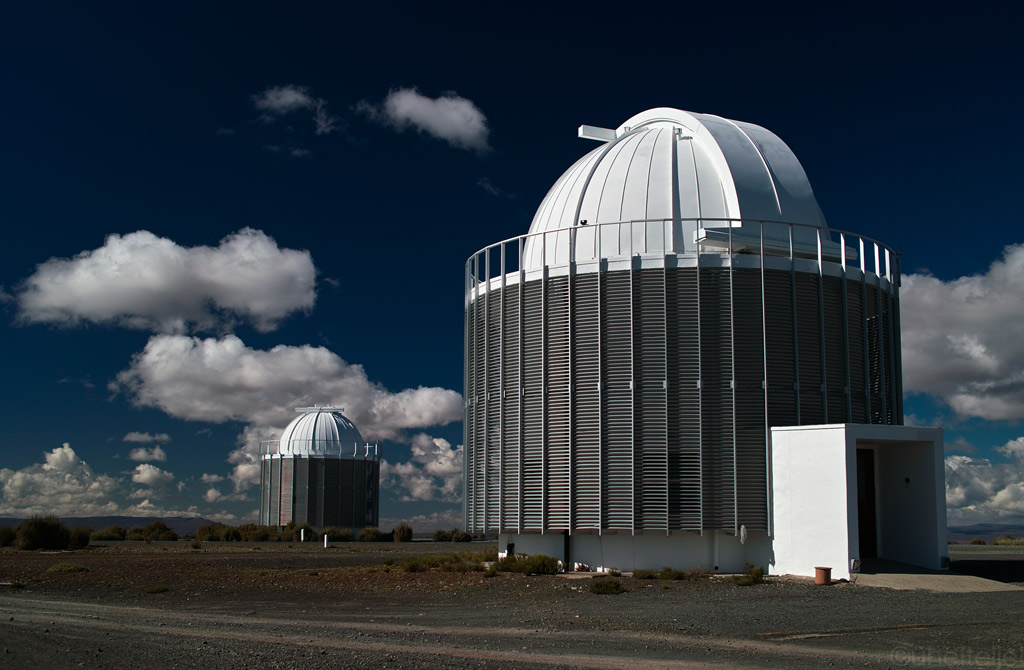
Loads of different telescopes in SAAO.
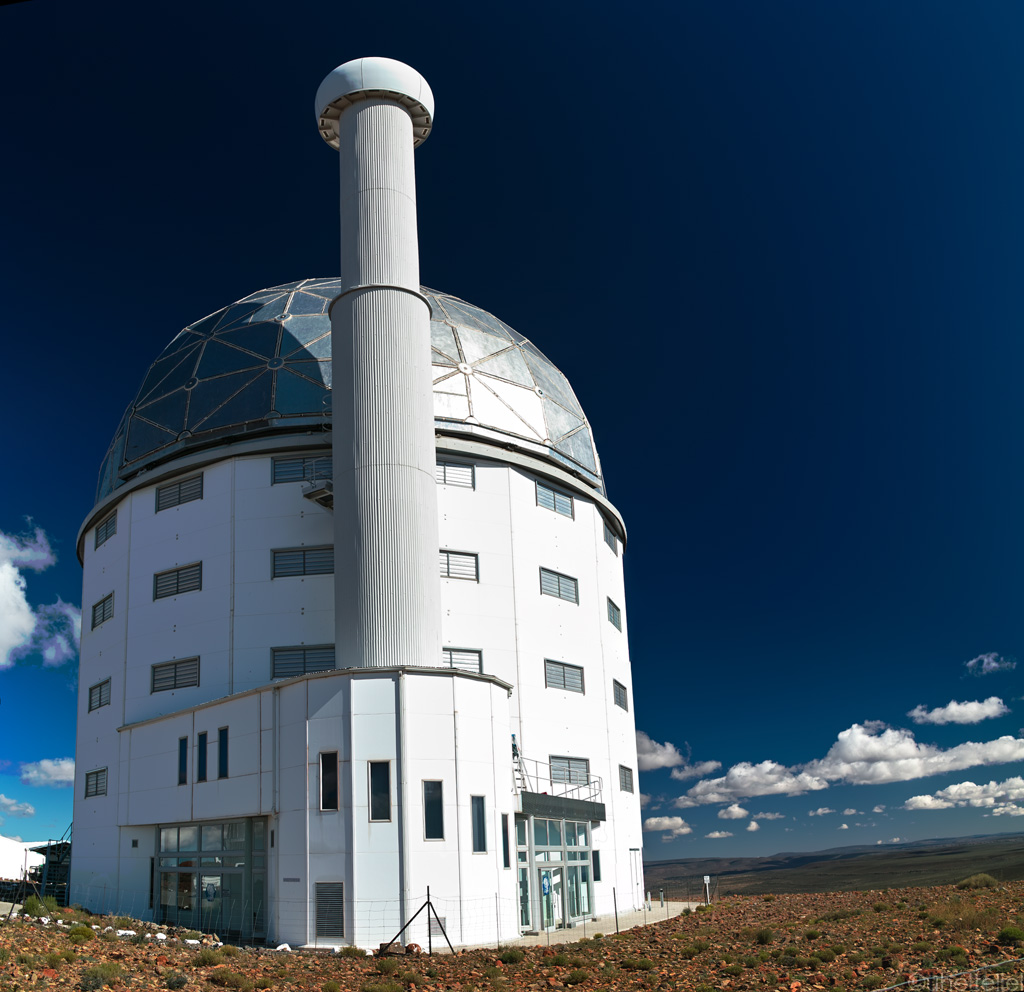
The biggest single telescope in souther hemisphere - SALT inside the main dome. The tower on the side is CCAS (Center of Curvature Alignment Sensor) that with it's lasers pointing to the sky it aids fine tuning the mosaic-mirrors with micrometer precision to have the best focus possible.
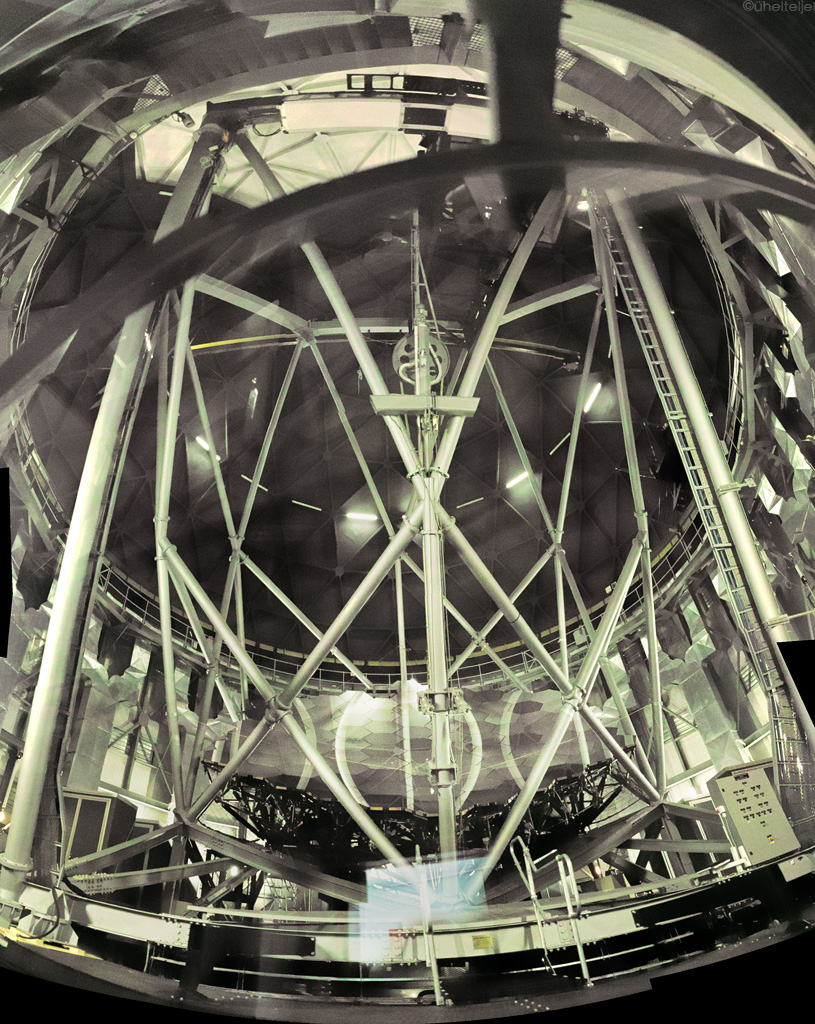
SALT from the inside - see the mosaic mirror below.
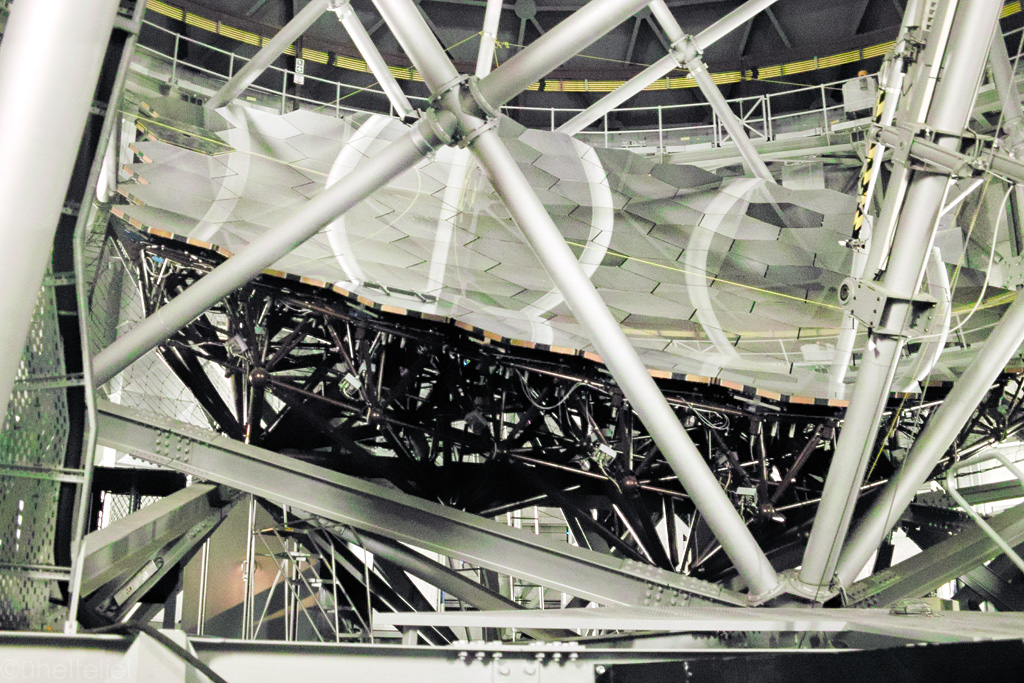
The mosaci mirror closer - check the frame supporting the mirror segments from below - each one has state of the art sensors and mechanics attached to it.

Panorama from SAAO (click to enlarge)

Panorama from the center of SAAO to see all the facilities (click to enlarge)
In the town of Sutherland we stayed at a campground where the owner had a fancy 11-inch mirror telescope, so we could see one of the symbols of the Southern Sky - the Southern Cross (not visible in the Northern Hemisphere) with its Jewel Box; also the light from Sirius, a star so low on the horizon it almost seemed to flash due to atmospheric disturbance; Saturn with its rings and moons, and of course our own Moon. Pretty syrreal indeed to see our satellite, trapped in Earth's gravitational field, scarred by countless meteorite encounters and the Sun's radiation through millions of years, and the vast, cold, dark emptiness just around its edge. It is hard to describe the feeling of seeing it. It is like looking at density in a void, just like we are. There was enough light reflected from the Moon so I could take a few pics through the lens.
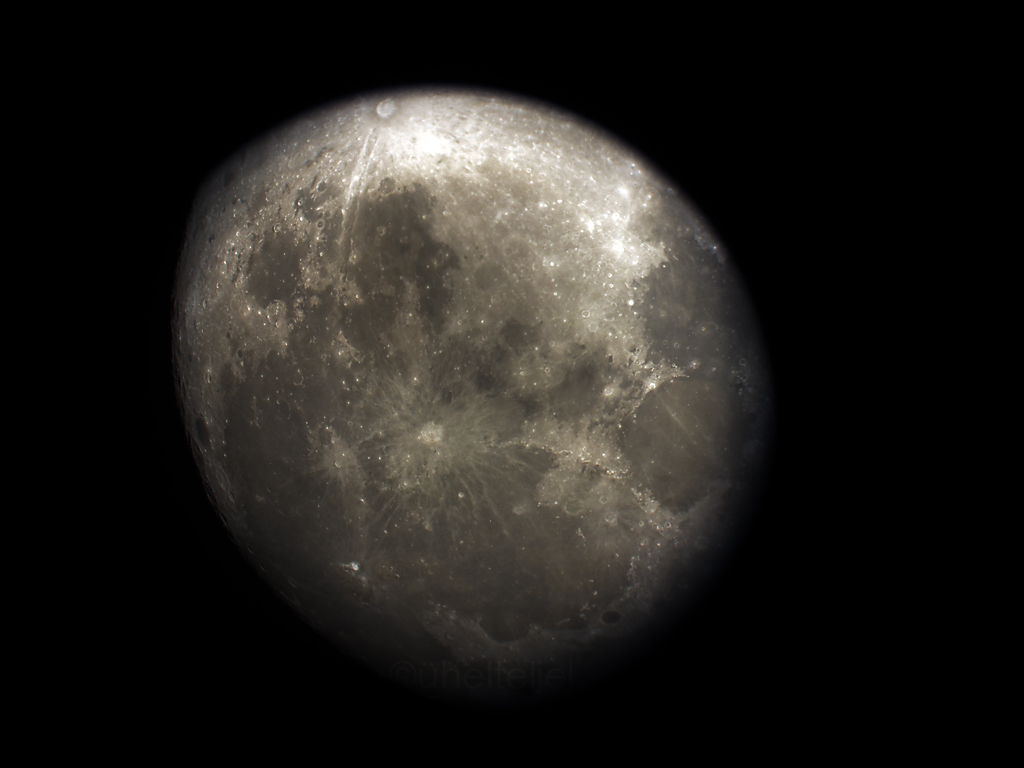
The Moon.
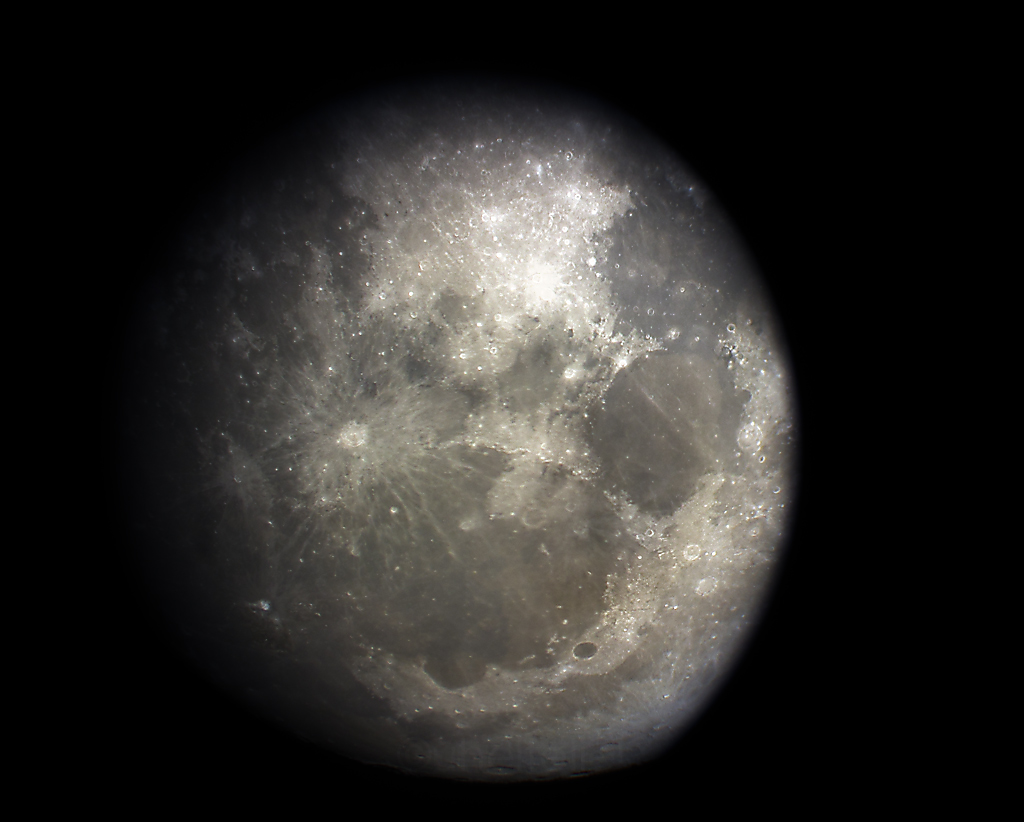
Oceans of the Moon.
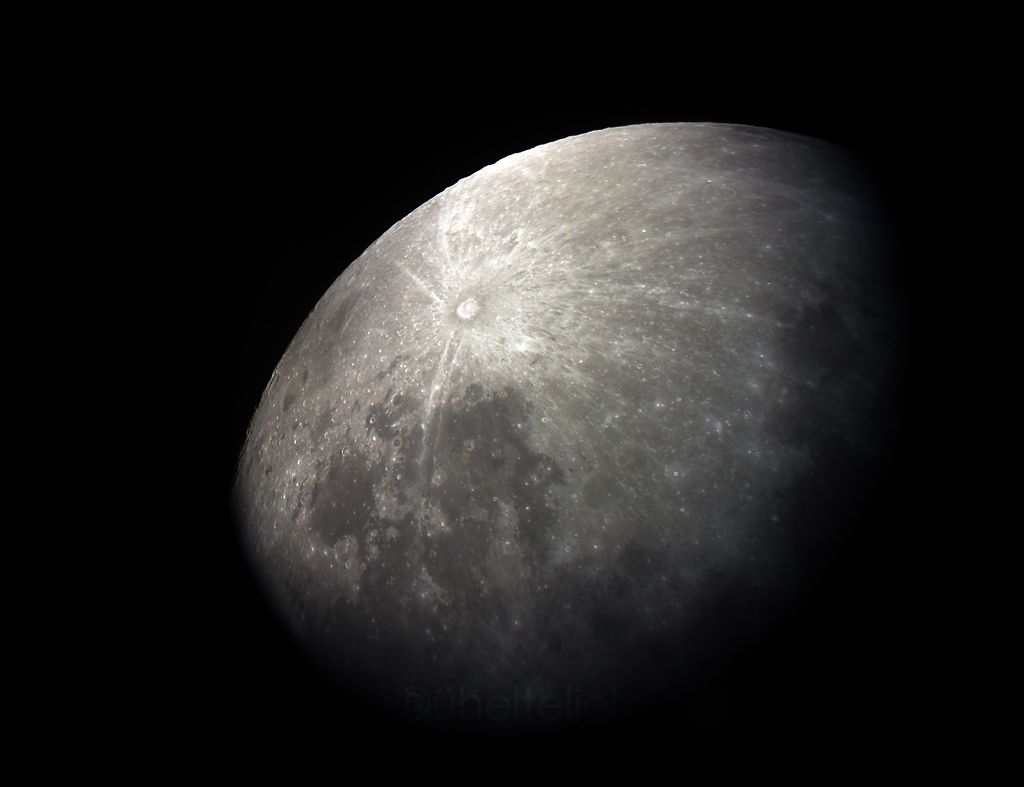
Crater of the Moon.
Hope you enjoyed the report,
Margus & Kariina

Waves in Coffee Bay.

Interesting rock formations on the beach.

Fisherman at Coffee Bay.

Funky plants at Coffee Bay.

A breaking wave and a funky plant.

Someone's door and a window, early morning at Coffee Bay.

Waves coming in at Port St. Johns, short distance away from Coffee Bay.

Panorama from Port St. Johns beach (click to enlarge)

Panorama of Coffee Bay (click to enlarge each panorama)


Panorama from another bay in Coffee Bay.

Panorama from Coffee Bay's rocky side of beach during dusk.


Panorama from a hiking trail somewhere in Coffee Bay.

Water against the rock...

Somewhere on the hiking trail.

Water coming in.

Play of the waves, stillness of the rocks...



After having seen enough of the frothy waters we headed to Gonubie, a town near East London. We were greeted by Michnus and Elsebie whom we had already met in Nairobi - they're both traveling on a F650 GS, and they had just left their bikes in Addis Abeba and flown back home to work for a while before continuing their journey somewhere north. They suggested we'd stay for a couple of days and that's what we did - exchanging our stories, drinking damn good Ethiopian coffee, having jaccuzzi, eating all sorts of delicacies such as BBQ'ed ostrich and the local speciality, biltong, and even meeting the epic ADV famer Metaljockey who lives only two houses from Michnus and Elsebie. We were totally spoiled!

Typical anvironment and architecture in the windy Transkei region - this is the Nelson Mandela land!

A house in East London.
The southern coast of South Africa has a different kind of aura. Kind of more peaceful and relaxed. And even though the ambience in the towns lining he Garden Route becomes more exclusive, and maybe even more cocky as we near Cape Town, the nature itself expresses itself in a rather sedate way.

Indian Ocean coast in South Africa.

Under a lighthouse built around the 19th century.

Indian ocean coast seen from that lighthouse.
The frigid waters bashing against the rocks, green fairytale-like hills rising in the background, the sky stretching towards the distant horizon - it must take a hell lot of will to keep all this might at bay. But there you stand on the shore, the waves splashing in front of your feet and the wind tearing your hair, and yet you do not feel overwhelmed. It is not trying to impress you to satisfy its vanity, instead it lets you decide what to think of it…

Panorama from the coastal road in South Africa (click to enlarge)

Panorama from False Bay.

A huge church in a small town in South Africa.

Waves in Tsitsikamma national park.
Sound from the same spot:
...::: LISTEN :::...

Still waters and seagulls in Tsitsikamma.

Trail to the beach.

Sandy landscapes near the Indian ocean.

Panorama from that world famous peninsula - somewhere there is Cape of Good Hope (click to enlarge).
Sure enough we could not miss Cape Agulhas, the southernmost point of the African continent. As exciting as such landmarks are, this one is sadly destined to be the one that marks the true start of our journey home as we will only be moving north from here.

Us in Cape Agulhas - one wants back to the less visited Indian Ocean countries, other to the more "homey" Atlantic Ocean countries.

This is how the most southern point of African continent looks like.

Panorama from Cape Agulhas (click to enlarge)

A sunken Japanese ship in Cape Agulhas.

The same Japanese ship, see the fisherment in the background?

Life on the rocks.

Almost like miniature volcanic mountains...

Under the Cape Agulhas lighthouse - second oldest in South Africa.

Closer.
In Cape Agulhas we caught some intriguing radio signals, one of them at 5998KHz, probably communication between lighthouses or ships going between the Indian and the Atlantic ocean?
...::: LISTEN :::...
And also long wave radio signals propagate over the Indian ocean, so we had a relatively good receiption of an Indian radio station bringing back some good memories from that particular country:
...::: LISTEN :::...
We did not spend too much time in Cape Town, although it proudly stands on many a traveller's final destination on their venture through Africa, something like a longing or a grand finale. For us it wasn't. We were there mainly for business - to apply for an Angolan visa which they say Cape Town is the most likely place to get one. Meanwhile we saw a little of the legend, but maybe it was because it was so little that we could not really appreciate what it had. It was very civilised though, so you could almost have it mixed up with some cities in the Old World, but somehow we missed that special something.
Or maybe not… While trying to find some space to park in the city centre, a guy called Stefan (if you happen to be reading this, please correct us if the spelling is wrong!) came talking to us, saying that he had been following us on ADVrider. Then he went and came back in a little while, and… put some money in my hand. It is only later that we counted the money and found it to be a considerable amount. We really felt humbled. Thank you Stefan!
And also, thanks to the anonymous guy in a Harley who rode past us on the N2 soon after Tsitsikamma National Park whom we caught again in a toll station queue and who waved us to pass him as he had paid the toll for us. Totally unexpected and absolutely heart warming!
South African biking community has received us extremely well, sending us invitation letters, providing us with food, shelter and heaps of useful information, and just being there for us. A great bunch of people. Thank you Ian, Conrad, Steve, Michnus, Elsebie, Donald, Charl and Sean!
But back to Cape Town. Considering the geography, we would have expected to find something similar to Rio de Janeiro, with all the sea and mountains. But it wasn't there. Maybe it just lacked the samba and the bossa nova, I don't know. Or was it that our minds were too much occupied with more mundane subjects such as the visas. Yeah, the Angolan visas. Hard to get and expensive. We'd go around that country if we could, but the only viable option would mean shipping the bike, and this does not sound interesting. So as soon as we hit Cape Town we headed to the consulate, where once again we were convinced that it would take a lot of money, paperwork and patience. In that order.
The money was perhaps the easiest, although not really painless - around 100 EUR per person for the 30-day visa. Not the cheapest, but hey, not the most expensive visa we've had so far either.
The paperwork was a headache, because unless you are applying for a five-day transit visa (which, considering the sheer size of Angola, is not impossible, but very tight, especially in the rainy season which has already begun) you need an invitation letter from an Angolan citizen/entity that has to be notarized and sent to the consulate from Angola. Finding a friend in Angola was not difficult as we had met in Nairobi a Portuguese guy called Gonçalo who had been working in Angola for quite while and was then travelling through Africa on his R1100GS, so he has some contacts. Notarizing the letter wasn't too difficult, but finding a fax in Angola… oh well, it obviously took days, but the consulate would not accept anything but a fax from Angola. Who would have imagined that even Angola has switched to internet by now, except for their foreign representation
We were told it would take 7-10 working days to have the applications processed. A long and nerv wrecking wait… Thanks to Donald and his kids who hosted us in Cape Town it wasn't that painful to get organized.
Not to become too frustrated while waiting we decided to play tourist a little and headed to Cape Peninsula just south of Cape Town. It was soon clear that it was not only us that had come to play tourist there as there were busloads of people there trying to fight off the ferocious winds while posing with various landmarks. But the landscape was truly fine, so no complaints.

Panorama from Cape Peninsula (click to enlarge)

Wider panorama (click to enlarge)

The bays had funky names - Neptune's Dairy.
It was, of course, nothing more than a one-day, or even a half-a-day ride, so it was not nearly enough to get our minds off the visas. So we took the decision to head out to Karoo which is basically a huge semidesert - huge enough to get lost for as many days as you could possibly like. We'd heard it would be something like central Australia where you can ride for hundreds of kilometers without seeing another vehicle and where the stars are particularly bright at night. The southern edge of Karoo is more mountainous and home to countless vineyards, so it seemed only logical to start from there.
Riding the roads in the Klein-Karoo, or Small-Karoo as this area is often referred to, offered a complete change of scenery, way of life and mindset from the bustle of a metropolis like Cape Town. Here too it was difficult to understand that it is actually Africa - the Old World style wine cellars and road houses, pubs like out of a Western looked and felt totally un-African. And the wine! What could be better than to open a bottle of nice local wine and to thing that regardless of all the trouble and uncertainty, life wasn't so bad.

The beginning of Karoo desert

Ronnies sex shop - actually it's just a pub.

Good South African wine to acompany us in the evening.

Ostriches.
One of the great highlights of the Small Karoo was the Swartberg pass across a mountain range with the same name. Truly spectacular, and offering a different perspective every 100 meters!

Panorama of Karoo near Swartberg pass (click to enlarge)

Panorama of Swartberg pass.

Panorama of mountanous Karoo.

Panorama from the road to Swartberg pass.

Climbing higher.

Mountain top in Karoo desert.

Crossing the Swartberg pass.

A canyon in Karoo.
Once we'd crossed the Swartberg Pass, there was a great change in scenery. We were in the Great Karoo. Broad, empty, lonely, full of power. No people, no cars, only a few lonesome sheep farms dotting the far horizon, with huge windpowered water pumps making slow, tired, squeaky turns. It would be great to life here for a while to let the thoughts to settle and to let the soul cool down.
We had quite a ride in the Great Karoo, without any specific plans or destinations, taking random tracks and just riding, taking in all that the journey had to offer. Hundreds of kilometers of gravel, revealing a new sight, a new formation behind every corner. Mountains in the morning mist, half dreamy half forgetful desert, a track running between rocks radiating the suffocating heat they'd accumulated. Just as if the time had stopped, and for us it had, because we could not care less if it was morning or evening. We just lingered.
By the end of the day we'd always manage to find a campsite (unfortunately, all the roadside is fenced in South Africa so you'd be lucky to find a spot for bush camping - I do not know if it is for the wild animals orif it is someone's private property) and enjoy the view of the stars in the Southern sky with a bottle of local wine. No, really, it would be great to live here for a while…

Typical Karoo landscape in panorama (click to enlarge each one)

Panorama from the road through Karoo National park.

Karoo landscape panorama.

Road through Karoo National park.

Helping a tortoise off the road.

Karoo colors.

Typical Karoo roads - all fenced by farmers.

Autoportrait of Tsiklonaut.

Leaveless trees in Karoo.

Wind operated waterpump - same like in Australia.

A riverbed in the Karoo.

Road...

Karoo rocky landscape with a lone tree.

Picture from the road.

Tasting South-African wines in the moonlight... All local stuff.

While in Montagu we drink the wine accordingly.

Since we had stellar ideas, a proper wine had to accompany them.

Close to Orange River we had a bottle of proper wine as well.

Since we don't carry a wine bottle opener we used more creative methods - GPS mount's spare U-bit.
The gravel tracks in the Karoo are a little shrewd though - most of the time one can go as fast as 120 km/h, the dust flying high behind, but there are some treacherous rust going across the road that one often notices only when it is already too late. Sure enough we went through at one of those at a great speed, the wheels lifting off the ground and the bike making a crashing sound as if it was about to break in half. At first inspection of the bike all seemed allright, but at one point we discovered that the bolt that is keeping the shock in place from the bottom looked funny, just as if it had come half loose. Who knows how long it had been like that. So I tightened it and rode on a little worried, because riding with a loose bolt can create abnormal tensions in the shock, and this is not good.
As we arrived in Sutherland we looked up a workshop, hoping to straighten up the bolt that we believed must have been bent, or to replace it, but as I tried unscrewing it, it became apparent that the bolt was not bent, but actually broken in two. It was a miracle we'd come so far with a broken bolt. We installed a new one, but I also had to bend the shock mount a little as it had been bent a little too because of the loose bolt. I am pretty sure it affects its strength too, so we really have to be careful from now on not to break the mount in tough conditions. Considering our shocks have all had some sort of curse placed on them, we would not be surprised if something went terribly wrong again. We are keeping our fingers crossed. If the shock blows I'm afraid it will not be the shock that we'll be shipping to Europe for repairs, but the whole bike and ourselves too. Counting the cents, there just isn't any space for mistakes left here on our journey back.

In the workshop in Sutherland - trying to reweld the sidestand and fix the suspension bolt.

Turned out the bolt had split into two! Through some magic it had carried us there.
The side stand, too, gave up while in the Great Karoo, the tiny little wire holding the springs just braking off the side stand. So before we arrived in Sutherland where we could get it welded, we had to ride with the side stand literally tied to the bike. Strange how things tend to start falling apart at the same time. Or maybe it is the mileage. With 225 000 kilometers on the clock, and counting, it is really no surprise. Most of it has accumulated in dubious road conditions, and under dubious loads. Add to that all the heat, air polluton, low quality olis and fuel, and… a combination that 99% of the GSes never see. Just keep our fingers crossed that this beast would take us home, back to Europe - it's a long way.
The Karoo is also home to the SAAO or the South African Astronomical Observatory, the biggest astronomical observatory on the whole continent. And to be totally honest, it was one of our main interests for visiting the Karoo in the firts place. Although not a tourist site as such, it is still possible to go to see the facility with a guide - an opportuity we could not miss.

Approaching to South African Astronomical Observatory - height is already 1700 meters above sealevel.
In addition to different telescopes there is a small exhibition explaning the functioning principles of spectrometers - the main tool in astronomy, and also featuring all sorts of other equipment and some fabulous photos of the distant corners of Time Space.
We got to see the Radcliffe telescope, which with its 1,9-metre main mirror was, until 2004, the largest in South Africa. Also interesting was BiSON (Birmingham Solar Oscillations Network) observing - surprisingly - the nearest of all stars - the Sun. What was especially interesting was that it is remote-controlled from England. So much about the romantic understanding of an astronomer's work - gazing at the stars through a telescope. This is distant past. Today all the data gathered through the telescopes goes to the computer which makes a whole lot of equations and draws a picture as a result. Or even not that much - rather it is the quantifiable characteristics of the stars that we are looking at now rather than the stars themselves.
We also got to see the SALT or the South African Large Telescope. With its 11-meter mosaic mirror, all the fine tuning, adaptiv optics and calibration it is a true monster telescope - and so far the largest single telescope on the Southern Hemisphere. Works well to explore in more detail such distant and old sections of the Universe like the quasars.
So in total there was a lot to see with all the robotic telescopes searching for extrasolar planets, and also the geodynamic equipment and a lot more, that one day would not be enough to see and learn about everything.
The best part of the "tour" was when it was officially over and we could go and contemplate the facility on our own, and to think of how tiny we are indeed in the Metagalaxy both in terms of time and space, and to let the imagination roam free.

SALT (South African Large Telescope) - 11 meters of state of the art telescope sits inside it.

Kariina filming surroundings on the SAAO territory.

BiSON (Birmingham Solar Oscillations Network) is with open door during daylight - observing our nearest star - The Sun. It's remotely controlled real time from UK. A testament to the making of modern science.

Seeing around SAAO with different telescopes.

Panorma from 1.5 metre telescope surroundings.

Many facilities are covered with special metal grille - improves thermodynamic stability inside where state of the art science equipment has to work.

Radcliffe telescope (with 1.9 meter main mirror). See Kariina on right to get the sense how big it is.

Wind direction and speed display - over 60kph winds the observations are stopped.

Loads of different telescopes in SAAO.

The biggest single telescope in souther hemisphere - SALT inside the main dome. The tower on the side is CCAS (Center of Curvature Alignment Sensor) that with it's lasers pointing to the sky it aids fine tuning the mosaic-mirrors with micrometer precision to have the best focus possible.

SALT from the inside - see the mosaic mirror below.

The mosaci mirror closer - check the frame supporting the mirror segments from below - each one has state of the art sensors and mechanics attached to it.

Panorama from SAAO (click to enlarge)

Panorama from the center of SAAO to see all the facilities (click to enlarge)
In the town of Sutherland we stayed at a campground where the owner had a fancy 11-inch mirror telescope, so we could see one of the symbols of the Southern Sky - the Southern Cross (not visible in the Northern Hemisphere) with its Jewel Box; also the light from Sirius, a star so low on the horizon it almost seemed to flash due to atmospheric disturbance; Saturn with its rings and moons, and of course our own Moon. Pretty syrreal indeed to see our satellite, trapped in Earth's gravitational field, scarred by countless meteorite encounters and the Sun's radiation through millions of years, and the vast, cold, dark emptiness just around its edge. It is hard to describe the feeling of seeing it. It is like looking at density in a void, just like we are. There was enough light reflected from the Moon so I could take a few pics through the lens.

The Moon.

Oceans of the Moon.

Crater of the Moon.
Hope you enjoyed the report,
Margus & Kariina

